Except for the Sun, which is native to Earth, all the stars appear as small bright dots in the dark night sky, located many light years away from us. As observers, their position in the sky constantly changes – they can rise above the horizon and disappear behind it. In the evening, they may be on one side, but by morning, they can be on a completely different side. However, this phenomenon is not caused by the stars moving in space, but rather by the rotation of the Earth. In relation to each other, the stars maintain a nearly constant position (from our perspective as Earthlings). This constancy has had a significant impact on the development of human civilization: people have identified constellations among the stars and have used them to orient themselves in both time and space. To help with the memorization and transmission of this accumulated knowledge, humans created star maps.
It is of significant importance for the observer to consider their own location, specifically which hemisphere they are in. If they are currently in the northern latitudes, they will see a specific set of constellations, whereas if they are in the southern latitudes, they will see a different set of constellations. One well-known anecdote that exemplifies this is that of navigators: when they cross the equator, they suddenly lose their main point of reference – the North Star – and find themselves in a state of helplessness until they become familiar with the unfamiliar southern sky. The advantage here is that there is no abrupt transition from one constellation to another; the sky transitions smoothly, and in addition to the constellations exclusive to the north or south, there are also what are known as equatorial constellations.
Star Groups
Constellations are artistic renditions of celestial arrangements that have been conceptualized by poets, farmers, and astronomers. Over the course of the past 6,000 years, these individuals have utilized recognizable shapes to create these imaginative depictions. The primary purpose of constellations is to facilitate the identification and understanding of stars. On a perfectly dark night, it is possible to observe 1000-1500 stars. However, without knowledge of constellations, it can be challenging to determine which stars are being observed. This is where the brightest constellations come into play, as they serve as recognizable markers within the night sky. For instance, if three bright stars are visible, one can deduce that they are observing a portion of the Orion constellation. With a bit of memorization, one can identify specific stars within Orion, such as Betelgeuse in the left shoulder and Rigel in the leg. Additionally, neighboring constellations, such as Canis Major, can also be observed. Charts and maps of constellations are available, providing names, locations, and notable stars. Additionally, each constellation is accompanied by photographs, illustrations, and intriguing facts. It is also important to consider the zodiacal constellations when exploring the starry sky.
The most up-to-date maps of the night sky, charts of constellations, and their online versions will be valuable to anyone who is fascinated by the vastness of the cosmos. Moreover, why not explore programs and services that offer the opportunity to explore the universe on a grand scale.
Star Patterns
For the constellations visible in the sky from the northern hemisphere, star patterns, known as asterisms, were utilized. Some of these asterisms have alternative names to make them more memorable and recognizable. For example, there is the Great Ladle (part of the Big Dipper) and the Small Ladle (part of the Little Dipper). The most popular star patterns are described below.
All of the adjacent constellations are classified based on the month, meaning their highest degree of visibility in the celestial sphere is entirely contingent upon the time of year. Consequently, when organizing them, they are divided into four distinct seasons (winter, spring, summer, and autumn). The key point to keep in mind is that if you are observing the constellations strictly according to the calendar, you should begin at 9:00 PM. If you are observing earlier, you must subtract half of the month, whereas if you start after 9:00 PM, you should add half.
For the sake of easy navigation, we have organized the names of all constellations in alphabetical order. This feature proves to be incredibly handy if you have a specific group in mind. It’s important to note that the diagrams only display the most prominent stars. For a more comprehensive understanding, it’s best to consult a star map or planisphere – a portable version. If you’re hungry for more intriguing facts about constellations, be sure to peruse our collection of articles:
Images of star patterns
To immerse yourself in the remarkable expanse of the universe, we have curated a compilation of the most extraordinary visuals and photographs showcasing renowned star patterns.
Star patterns in the winter, spring, summer, and autumn sky
Star patterns in alphabetical sequence
| Small Dog | Canis Minor | CMi | 183 | 20 |
| Microscope | Microscopium | Mic | 210 | 20 |
| Fly | Musca | Mus | 138 | 30 |
| Pump | Antlia | Ant | 239 | 20 |
| Naugolnik | Norma | Nor | 165 | 20 |
| Aries | Aries | Ari | 441 | 50 |
| Octant | Octans | Oct | 291 | 35 |
| Eagle | Aquila | Aql | 652 | 70 |
| Orion | Orion | Ori | 594 | 120 |
| Peacock | Pavo | Pav | 378 | 45 |
| Sails | Vela | Vel | 500 | 110 |
| Pegasus | Pegasus | Peg | 1121 | 100 |
| Perseus | Perseus | Per | 615 | 90 |
| Furnace | Fornax | For | 398 | 35 |
| Bird of Paradise | Apus | Aps | 206 | 20 |
| Cancer | Cancer | Cnc | 506 | 60 |
| Incisor | Caelum | Cae | 125 | 10 |
| Pisces | Pisces | Psc | 889 | 75 |
| Lynx | Lynx | Lyn | 545 | 60 |
| Northern Crown | Corona Borealis | CrB | 179 | 20 |
| Sextant | Sextans | Sex | 314 | 25 |
| Reticulum | Reticulum | Ret | 114 | 15 |
| Scorpion | Scorpius | Sco | 497 | 100 |
| Sculptor | Sculptor | Scl | 475 | 30 |
| Table Mountain | Mensa | Men | 153 | 15 |
| Arrow | Sagitta | Sge | 80 | 20 |
| Sagittarius | Sagittarius | Sgr | 867 | 115 |
| Telescope | Telescopium | Tel | 252 | 30 |
| Taurus | Taurus | Tau | 797 | 125 |
| Triangle | Triangulum | Tri | 132 | 15 |
| Tucana | Tucana | Tuc | 295 | 25 |
| Phoenix | Phoenix | Phe | 469 | 40 |
| Chameleon | Chamaeleon | Cha | 132 | 20 |
| Centaurus (Centaurus) | Centaurus | Cen | 1060 | 150 |
| Cepheus | Cepheus | Cep | 588 | 60 |
| Circulus | Circinus | Cir | 93 | 20 |
| Clock | Horologium | Hor | 249 | 20 |
| Cup | Crater | Crt | 282 | 20 |
| Shield | Scutum | Sct | 109 | 20 |
| Eridanus | Eridanus | Eri | 1138 | 100 |
| Southern Hydra | Hydrus | Hyi | 243 | 20 |
| Southern Corona | Corona Australis | CrA | 128 | 25 |
| Southern Fish | Piscis Austrinus | PsA | 245 | 25 |
| Southern Cross | Crux | Cru | 68 | 30 |
| Southern Triangle | Triangulum Australe | TrA | 110 | 20 |
| Lizard | Lacerta | Lac | 201 | 35 |
The demarcation of constellations was established in the early 20th century, effectively separating them into distinct regions. In total, there are 88 constellations, with 48 of them originating from the Greek constellations depicted by Ptolemy during the 2nd century. The final delineation was completed in 1922 with the assistance of American astronomer Henry Norris Russell. The precise boundaries of the constellations were defined in 1930 by Belgian astronomer Eugene Delport, who employed vertical and horizontal lines to demarcate each region.
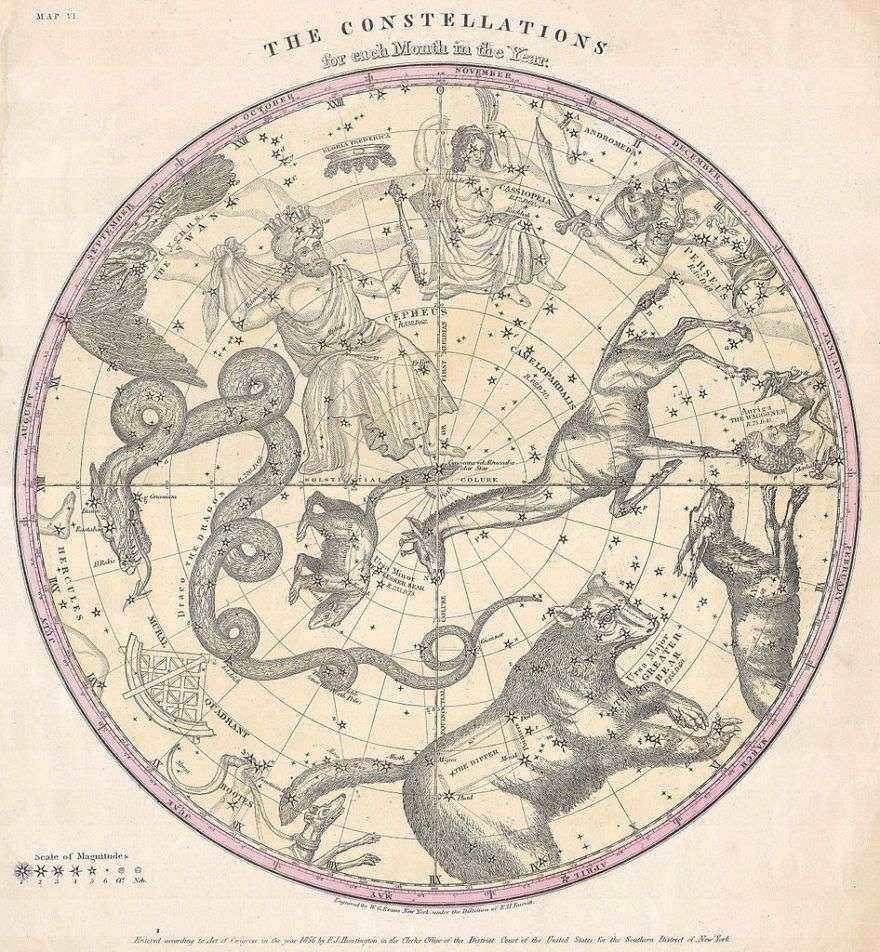
A map of the constellations in the northern hemisphere in 1856 is presented here in a unique color format by W. J. Evans. The level of detail in the drawings is remarkable, featuring the zodiacal figures. Notable constellations include the Big Dipper, Little Dipper, Dragon, Perseus, Cassiopeia, Giraffe, and Cepheus.
Many of these constellations retain the names given to them by their predecessors, with 50 originating from Rome, Greece, and the Middle East, and 38 being more modern. However, constellations have come and gone throughout human history, depending on the culture. For instance, the Wall Quadrant constellation was established in 1795, but was later split into the Dragon and Volopas constellations.
Another example is the Greek constellation Ship Argo, which was divided into Keel, Sails, and Stern by Nicholas Louis de Lacaille. This division was officially cataloged in 1763.
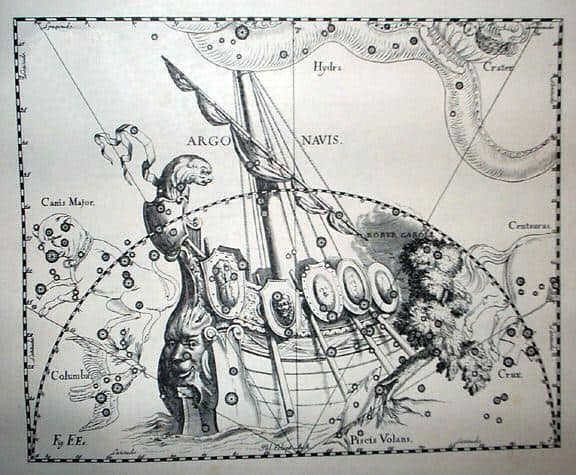
The Argo Constellation Ship was created in 1690.
When scientists talk about stars and objects, they mean that they are located within the boundaries of these constellations. However, it’s important to note that the constellations themselves are not physically real. In reality, all stars and nebulae are actually far away and even flat (although from Earth, they appear as flat lines).
Furthermore, because of their distance, there is also a time delay in what we observe. This means that the stars and objects we see may actually look different now than they did in the past. For example, Antares in the Scorpius constellation is located 550 light years away from us, which is why it appears the same as it did in the past. The same goes for the three-dimensional Sagittarius Nebula, which is located 5200 light years away. There are even more distant objects, such as NGC 4038 in the Raven constellation, which is located 45 million light years away.
Definition
A constellation is a unique arrangement of stars that forms a distinct shape in the night sky. Alternatively, it can refer to one of the 88 officially recognized configurations of stars. According to certain dictionaries, a constellation can also be defined as a specific grouping of stars that symbolizes a celestial being and is assigned a name.
History
In ancient times, people would observe the stars and identify patterns that resembled various animals or legendary figures. These patterns were then used to create stories, aiding in the memorization of star locations.
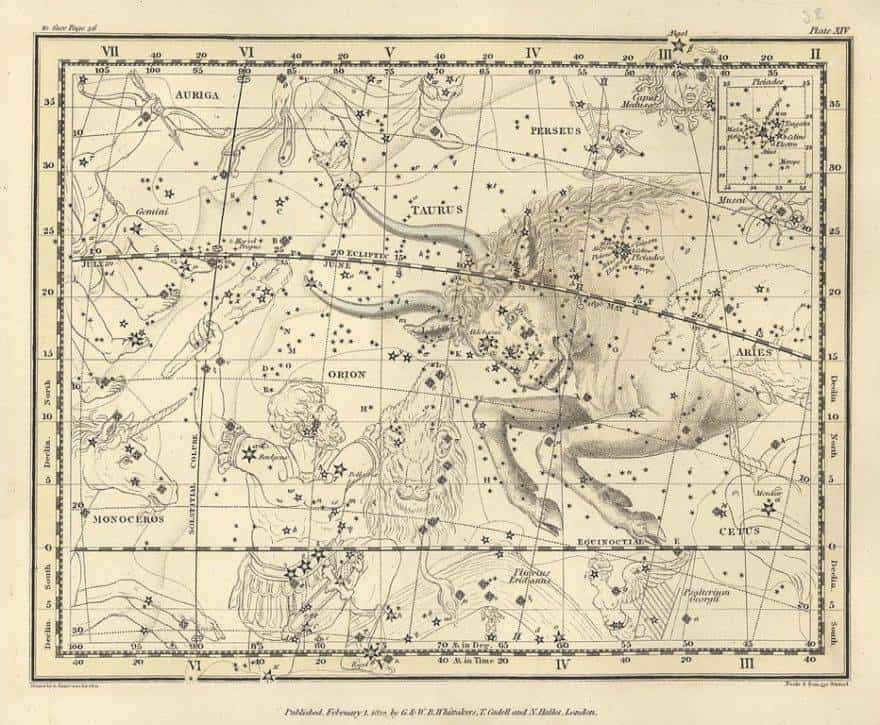
There are 13 cards in this plate depicting the constellations of Orion and Taurus.
Throughout centuries, Orion and Taurus have been revered by different cultures and have been associated with various legends. When astronomers started creating their first celestial maps, they incorporated the existing myths.
The term “constellation” originates from the Latin word “constellātiō,” which means “a multitude with stars.” According to the Roman soldier and historian Ammianus Marcellinus, it started being used in the 4th century. The word was adopted into English in the 14th century, initially referring to planetary unions. It wasn’t until the mid-16th century that it acquired its modern meaning.
The catalog is based on the 48 Greek constellations proposed by Ptolemy. However, Ptolemy only documented the discoveries of the Greek astronomer Eudoxus Cnidus, who brought astronomy to Babylon in the 4th century BC. Around 30 of these constellations have ancient origins, with some even dating back to the Bronze Age.
As the Greeks adopted Babylonian astronomy, the constellations began to overlap and merge. Many of them could not be observed by the Greeks, Babylonians, Arabs, or Chinese due to their lack of visibility. The southern constellations were recorded in the late 16th century by Dutch navigators Federico de Houtman and Pieter Dirkszoon Keyser. These constellations were later included in Johann Bayer’s star atlas, Uranometria (1603).
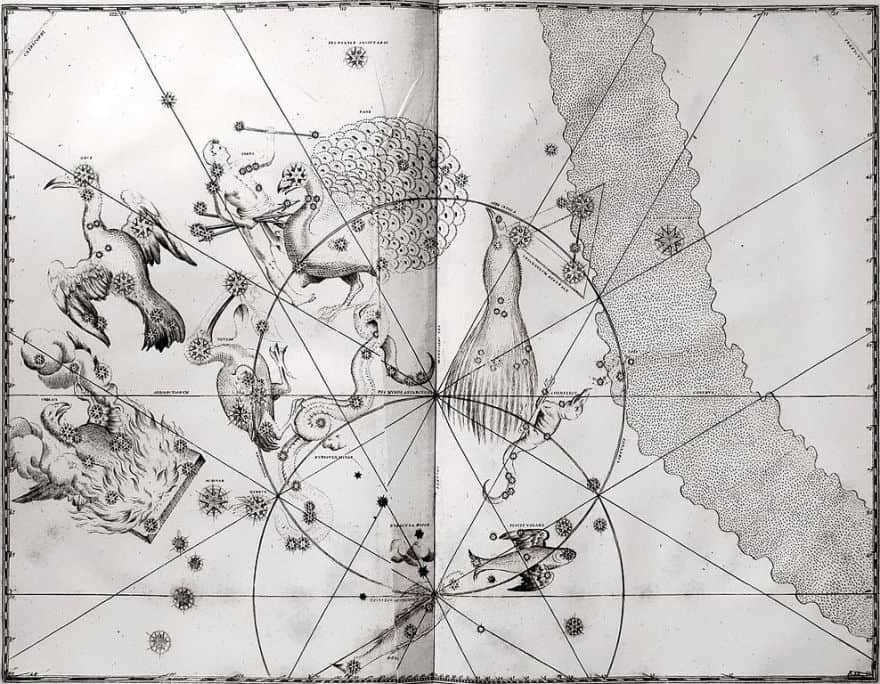
An illustration from Johann Bayer’s Uranometria, depicting the recently discovered constellations in the southern hemisphere.
Bayer introduced 11 new constellations, which included Toucan, Fly, Goldfish, Indian, and Phoenix. He also assigned Greek letters to approximately 1,564 stars, ranking them by their brightness (starting with Alpha). These designations have endured over time and now form part of the 10,000 stars visible without the aid of instruments. Some stars have acquired full names due to their exceptionally strong brightness (such as Aldebaran, Betelgeuse, and others).
Nicholas Louis de Lacaille, a French astronomer, added several constellations to the southern sky. His catalog was published in 1756, and he identified 13 new constellations. Notable examples include Octanthus, Painter, Furnace, Table Mountain, and Pump.
Out of the 88 constellations, 36 can be found in the northern sky while the remaining 52 are located in the southern sky.
Author’s Perspective
Constellations serve as an invaluable tool for acquainting oneself with the vast expanse of stars that adorn our night sky. By familiarizing oneself with these constellations, one can bear witness to the awe-inspiring wonders of the cosmos.
For those who are new to the world of amateur astronomy, understanding constellations is the first step towards progress. Without this knowledge, one may struggle to locate celestial objects such as the Andromeda galaxy. It is natural to feel overwhelmed when initially attempting to comprehend the intricacies of the celestial sphere, but with dedication, it is entirely achievable.
Do you remember your first day of school? It was filled with so many unfamiliar faces, new objects, and strange surroundings. But even then, you managed to strike up a conversation with someone and gradually, day by day, you adapted until you became comfortable in your own skin. Just like making friends, constellations can open up a whole new world for us. Instead of fearing them, we should embrace them and get to know them.
The night sky full of stars is absolutely mesmerizing, especially on a clear cloudless night. One can’t help but gaze up at the sky and try to identify the various configurations and familiar shapes that the stars create. And they are indeed real and defined. This leads us to wonder, just how many constellations are there in the sky? Let’s explore and find the answer together.
Astronomers of the past on the subject of stars
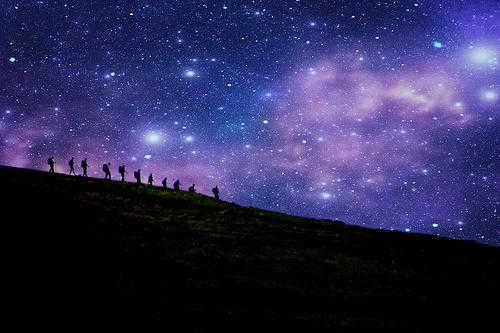
Ancient Greek astronomers were the first to categorize stars into constellations thousands of years ago. They did so based on their resemblance to mythical heroes, animals, and birds. They selected the brightest stars or groups that were located close to each other. The names they gave to these constellations didn’t always accurately reflect the figures they formed. However, today it’s difficult for us to know for sure. We do know that there are constellations like Andromeda, Pegasus, Hercules, Centaurus, Cassiopeia, and many others in the sky.
So, how many constellations are there in the sky? The ancient Greek astronomers identified 48, but that was certainly not all of them.
The celestial sphere and its divisions
The contemporary understanding of “constellation” differs from its ancient definition. In the past, astronomers used this term to describe patterns formed by stars. Sometimes, it would happen that the same stars could belong to multiple constellations, and in regions where stars were scarce or too dim, no constellations would be designated at all.
So, how many constellations currently divide the sky? Today, this term refers to the regions or sectors that facilitate the navigation of the celestial sphere.
The International Astronomical Union took on the task of defining the division of constellations’ boundaries in the early 19th century. This extensive project lasted from 1922 to 1935 and ultimately established the precise boundaries and total number of constellations. Thus, it was during this period that the exact count of 88 constellations in the sky was determined.
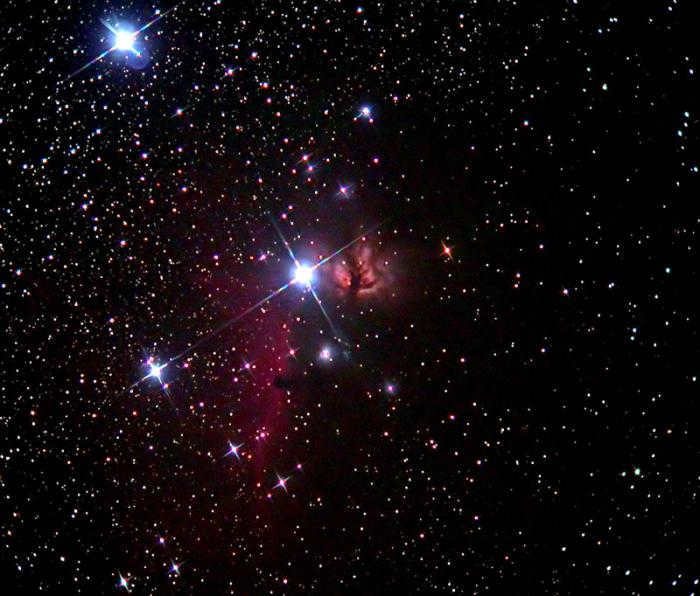
Not all constellations are visible
The Greeks may have discovered additional constellations, but their observations were mainly limited to the northern hemisphere accessible from the south of Europe. Ongoing studies in the seventeenth and eighteenth centuries revealed that it is impossible to see all the constellations at once. As our planet orbits the Sun, different groups of stars come into view. Constellations near the celestial pole can be seen throughout the year, while others are only visible during specific seasons, such as summer or winter, spring or fall.
Where can one find constellations?
Have you ever wondered where to look for constellations in the sky? Well, fear no more because we have the answer. There are a total of 31 constellations located in the Northern hemisphere, while the Southern hemisphere is home to 48 constellations. Interestingly, there are 9 constellations that can be spotted in both hemispheres as they straddle the celestial equator. These celestial wonders include Pisces, Orion, Whale, Unicorn, Virgo, Sextant, Snake, Eagle, and Serpentor.
The most brilliant
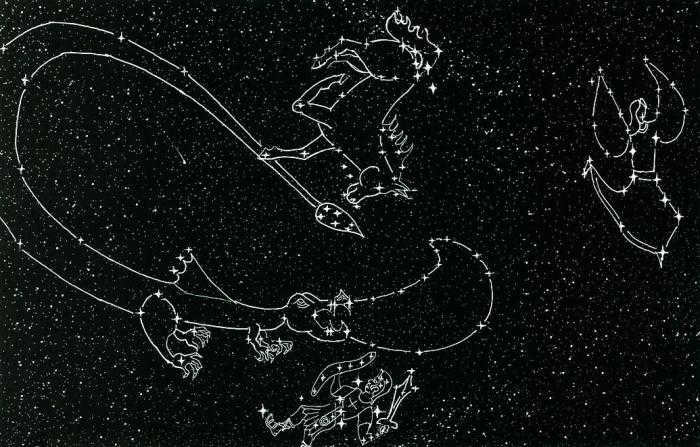
Out of the total 88 constellations, only 30 are easily recognizable due to their distinct shapes and bright stars.
The largest among the brightest constellations is the Big Dipper, which spans an area of approximately 1,300 square degrees. In addition to the seven prominent stars that form the dipper, there are another 118 stars that can be seen with the naked eye from Earth.
The smallest of the brighter constellations can be found in the southern hemisphere of the sky. Unfortunately, it is not visible from the territory of Russia. This enchanting constellation is known as the Southern Cross and covers an area of 68 square degrees. It consists of five bright stars and twenty-five faint stars.
The constellation of Scorpius contains the highest number of bright stars. There are a total of twelve stars in this constellation.
However, the constellation of Orion can be considered the most stunning. It boasts a total of 120 visible stars, with seven of them shining brightly.
What is the total number of constellations in the Zodiac?
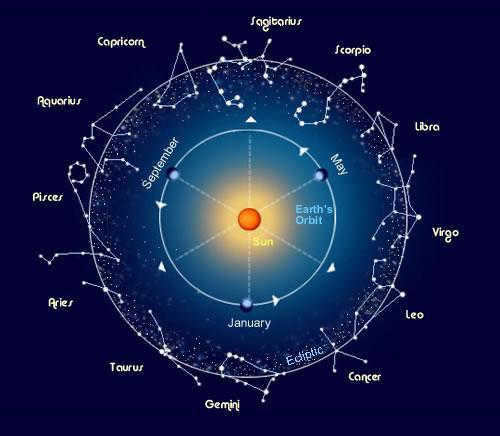
The zodiac consists of twelve constellations that the Sun passes through during its annual revolution. These constellations, located along the ecliptic, form a circle on the celestial sphere. Each month is associated with a specific constellation, depending on the Sun’s position. However, due to the movement of the vernal equinox point, the Sun now spends time in two adjacent constellations each month, instead of just one.
Out of the twelve constellations, Virgo is the longest one that the Sun spends time in, with a duration of 44 days. On the other hand, Scorpio has the shortest duration, with only six days.
We have determined how many constellations there are in the sky and in the Zodiac. However, the question remains: why does Taurus hold such a prominent position among the zodiacal constellations? The answer is simple. In ancient times, the importance of cattle breeding was highly valued. The bull, symbolized by Taurus, was highly respected and even considered a sacred animal. As a result, this constellation became associated with the Sun’s victory over winter and the arrival of spring, symbolizing the awakening of nature.
There are several legends surrounding the origin of the name Cancer. According to classical ancient mythology, when Heracles battled the Hydra, he was also attacked by a gigantic crab, known as Cancer. The hero defeated the crab, but in revenge, the goddess Hera placed Cancer in the sky.
Libra is the lone constellation within the Zodiac that is not connected to creatures or semi-creatures. Roughly two thousand years in the past, Libra represented the autumnal equinox. It is possible that this name emerged due to the equal length of day and night during this time. Another theory suggests that Astrea, the daughter of Zeus and Themis and the goddess of justice, used Libra to weigh the destinies of individuals, a constellation placed in the heavens by her father.
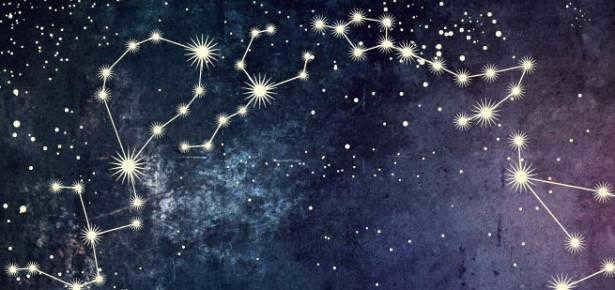
The constellation of Scorpio earned its name not only due to its physical resemblance, but also because it marks the arrival of autumn, a season when nature appears to go into a deep slumber or perish, as if ensnared by a venomous vine.
With numerous constellations adorning the night sky, there are just as many unique and intriguing names, each hiding a hidden significance within. This is particularly true for those names that were bestowed upon them in ancient times.
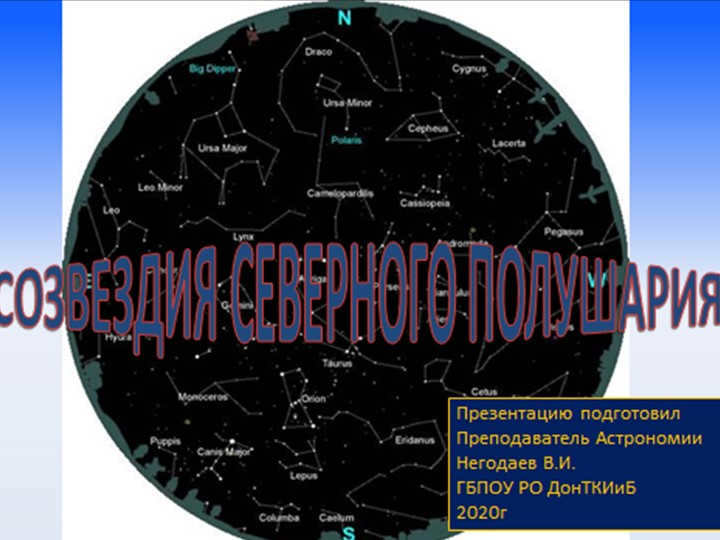
Currently, a total of 58,743 educational institutions are eligible for extra cumulative discounts ranging from 2% to 25%. To determine the specific discount applicable to all staff members of your educational institution, please access your personal Infoworks account.


Course for professional growth
Professional and personal development of teaching staff in the field of supplementary education through the implementation of the professional standard “Pedagogue of supplementary education for children and adults”.
In addition, your educational institution may also offer a discount based on the number of your colleagues who have completed Infowork courses.
Currently, 58,743 educational institutions are eligible for additional discounts ranging from 2% to 25%. To find out the discount applicable to all employees of your educational institution, please log in to your personal Infoworks account.


Advanced training program
Pump maintenance and operation techniques
In addition to this offer, we can apply a special discount for your school (the discount amount is based on the number of your colleagues who have completed Infoworks courses)
Currently, there are 58,743 educational institutions eligible for extra savings (ranging from 2% to 25%). To determine the discount available for all staff members of your school, please log in to your personal Infoworks account.


Getting ready for the USE in literature. The artistic uniqueness of D. I. Fonvizin’s play “Nedorosl”
Summary of each slide:

2 slide A constellation is a collection of stars that come together to form a distinctive shape in the sky. These stars are connected by their shared position and the stories and legends that have been passed down through history.
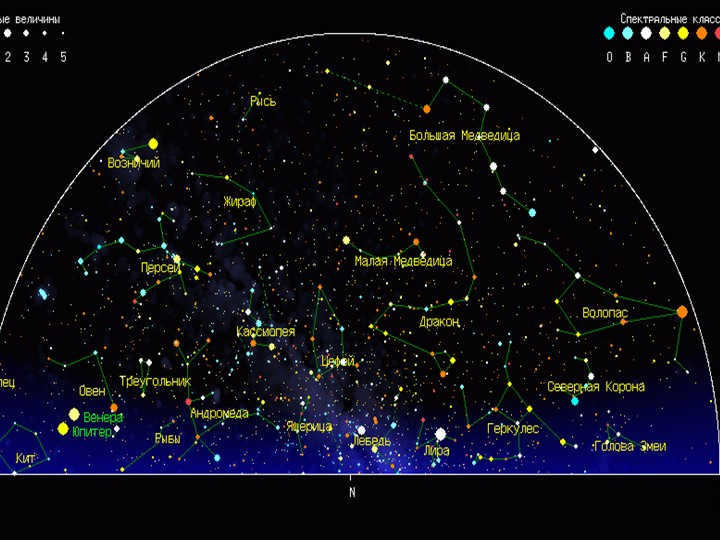
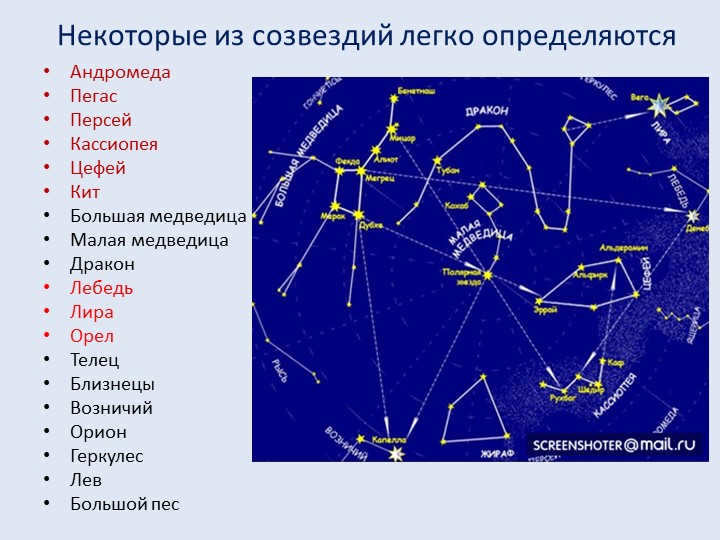
On the 5th slide, there are several constellations that can be easily recognized. Some of them include:
– Andromeda
– Pegasus
– Perseus
– Cassiopeia
– Cepheus
– Whale
– Great Bear
– Little Bear
– Dragon
– Swan
– Lyre
– Eagle
– Taurus
– Gemini
– Ascendant
– Orion
– Hercules
– Lion
– Big Dog
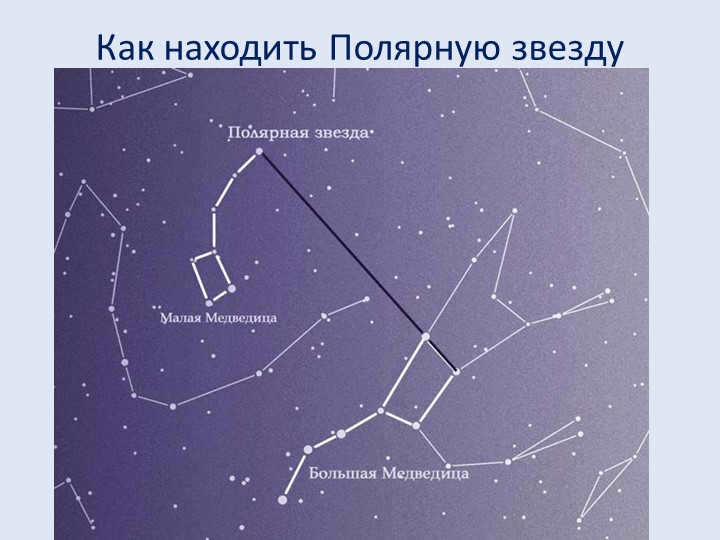
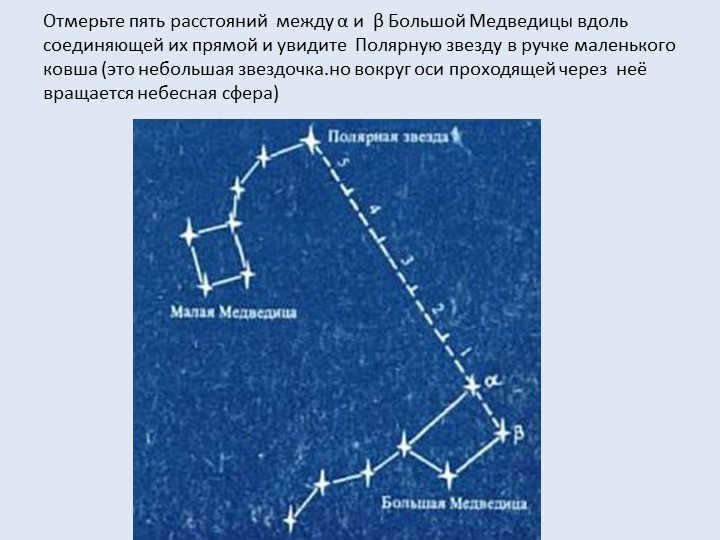
If you measure the five distances between α and β of the Big Dipper along the line connecting them, you will notice that Polaris can be found in the handle of a small dipper. This star may be small, but it holds significance as the celestial sphere rotates around the axis passing through it.
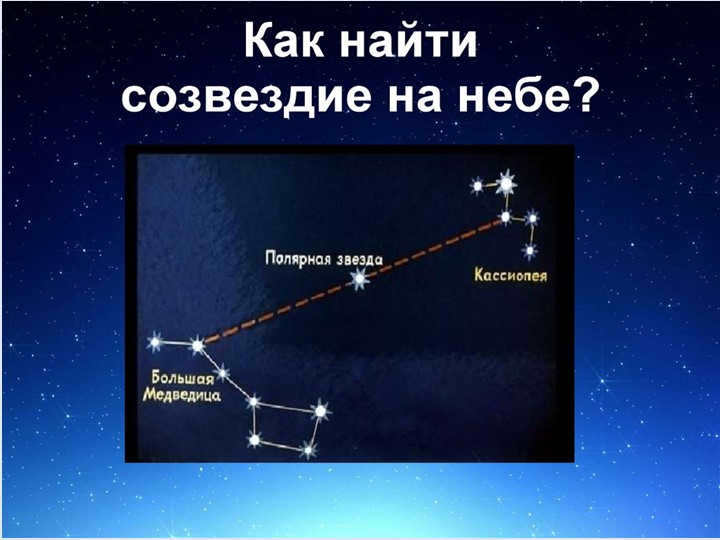
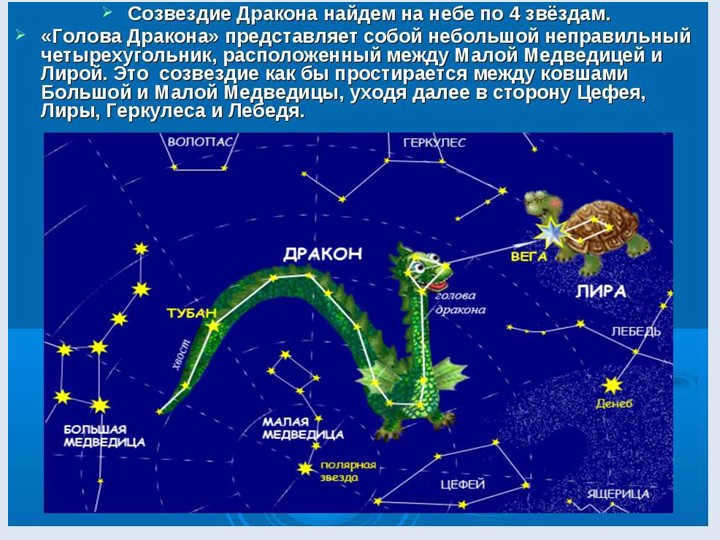
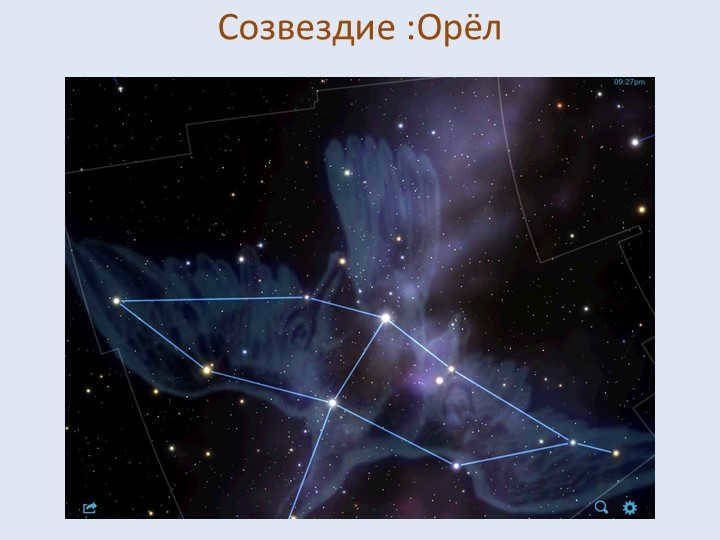
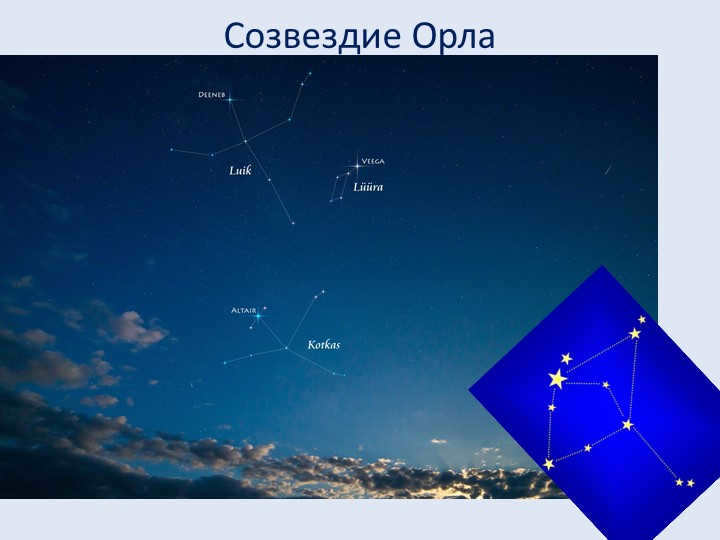
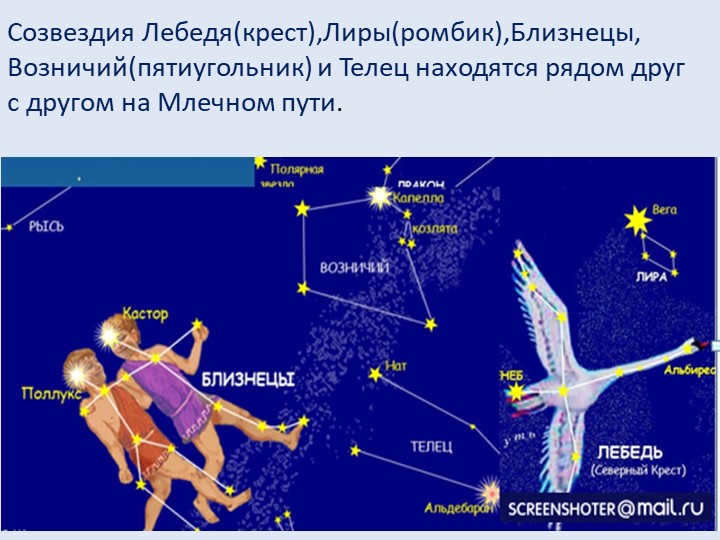
13 slide The Swan (cross), Lyra (rhombus), Gemini, Ascendant (pentagon) and Taurus constellations are in close proximity to each other within the Milky Way.
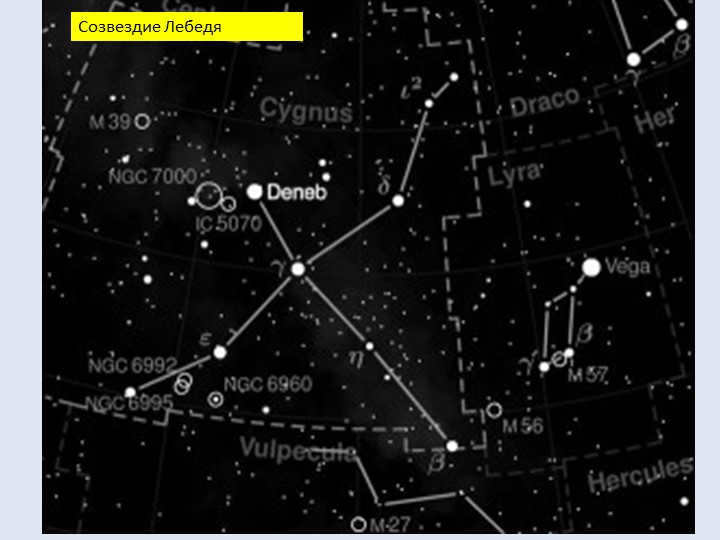
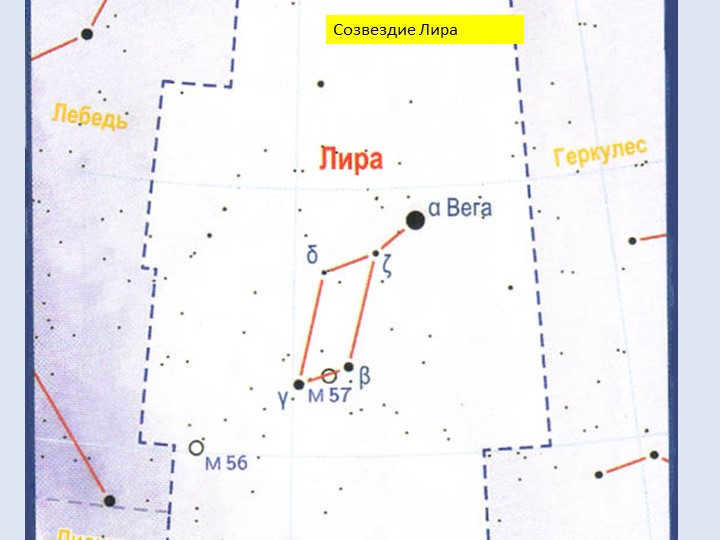
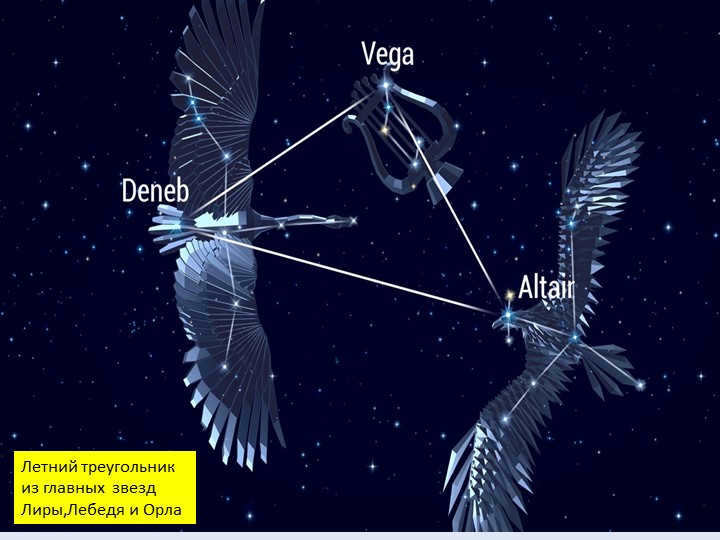

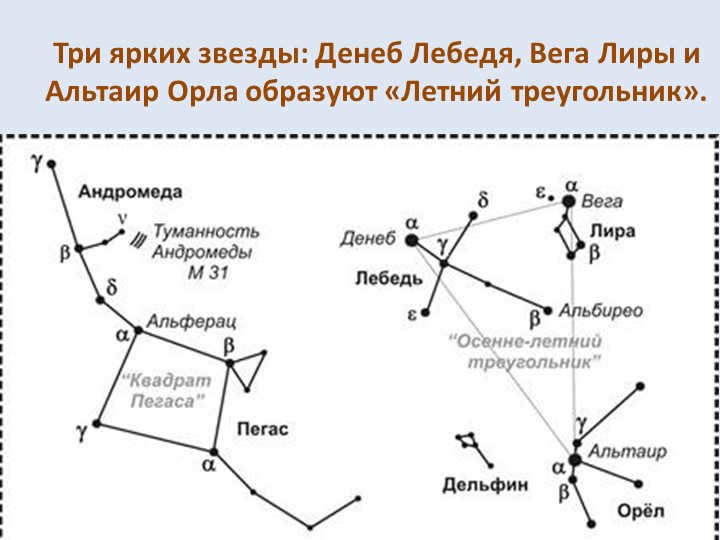
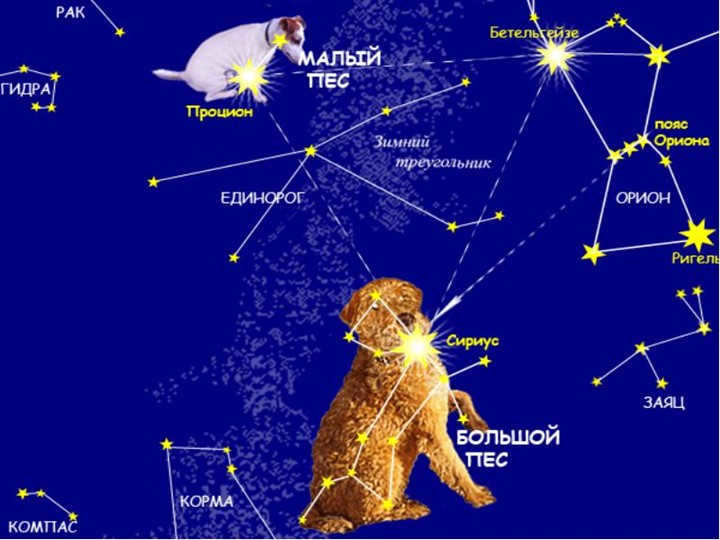
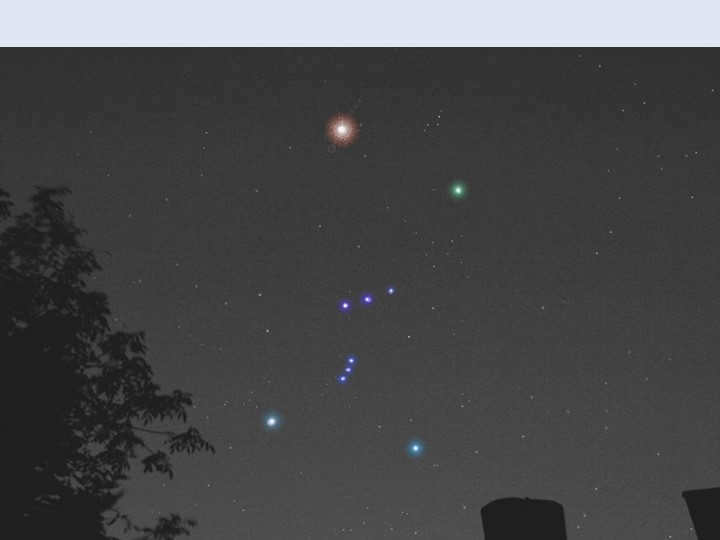

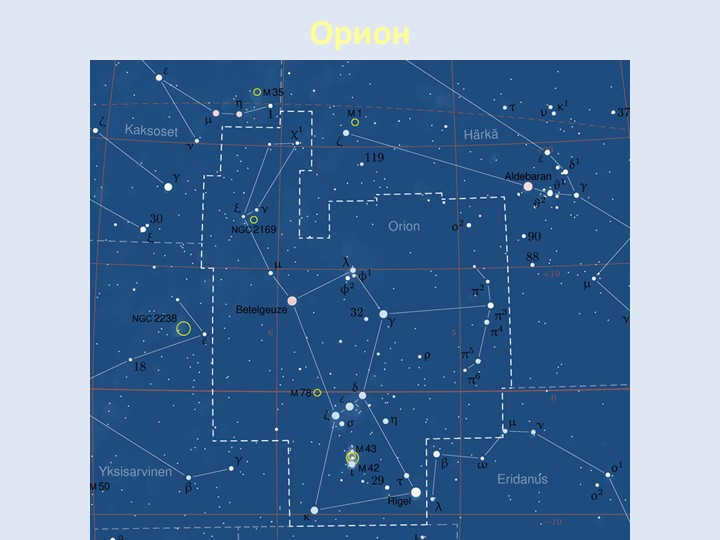



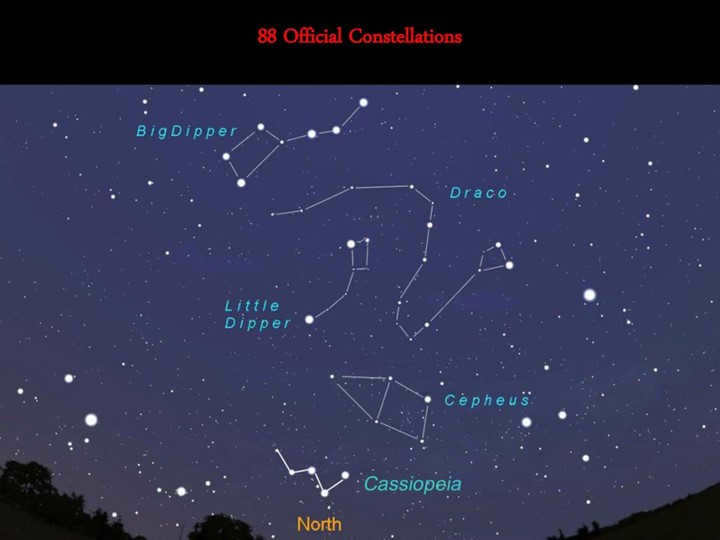
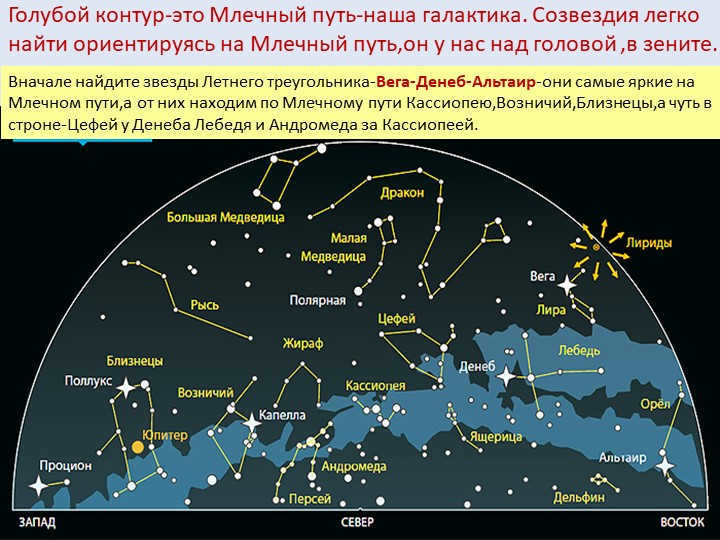
Slide 28: The Milky Way, our galaxy, is represented by a blue outline. One can easily locate constellations by observing the Milky Way, which appears above us in the zenith.
To begin, identify the stars of the Summer Triangle – Vega, Deneb, and Altair – as they are the most prominent in the Milky Way. From there, we can locate Cassiopeia, the Ascendant, Gemini, and, a bit further away, Cepheus near Deneb the Swan and Andromeda behind Cassiopeia.
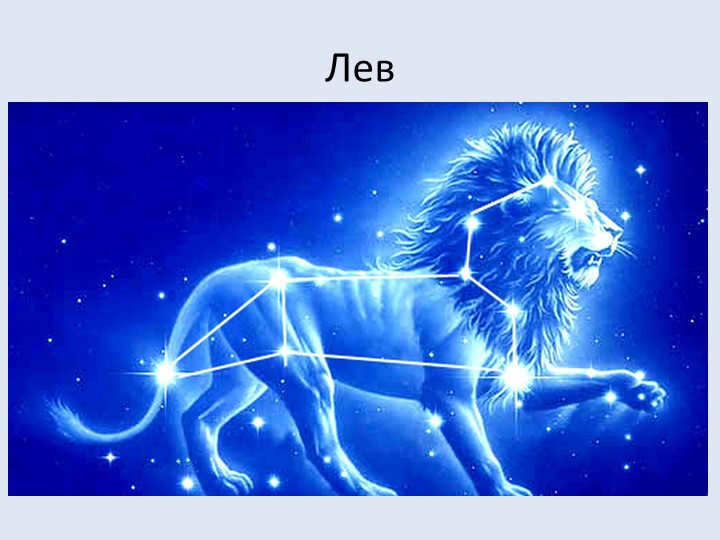
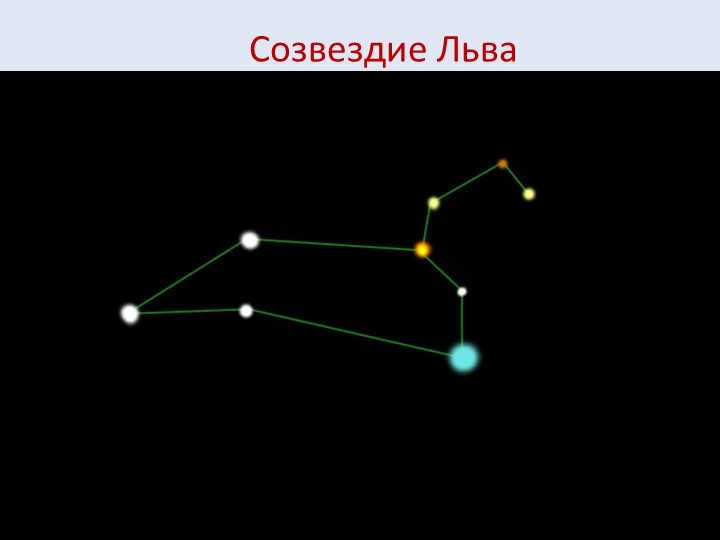
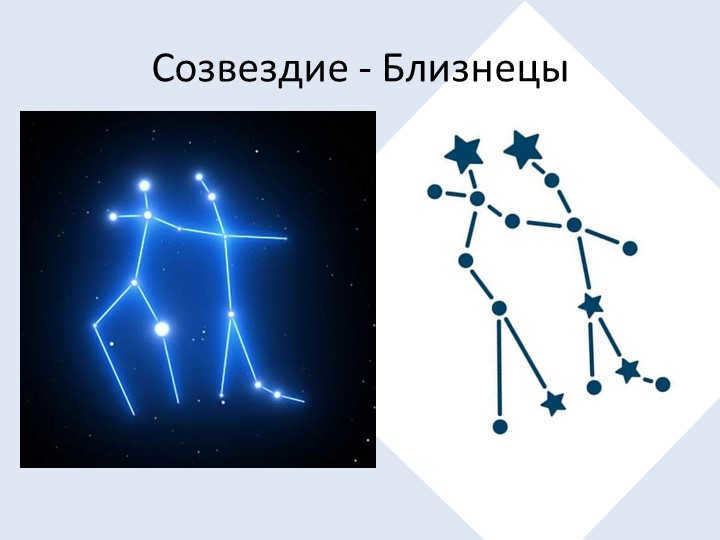
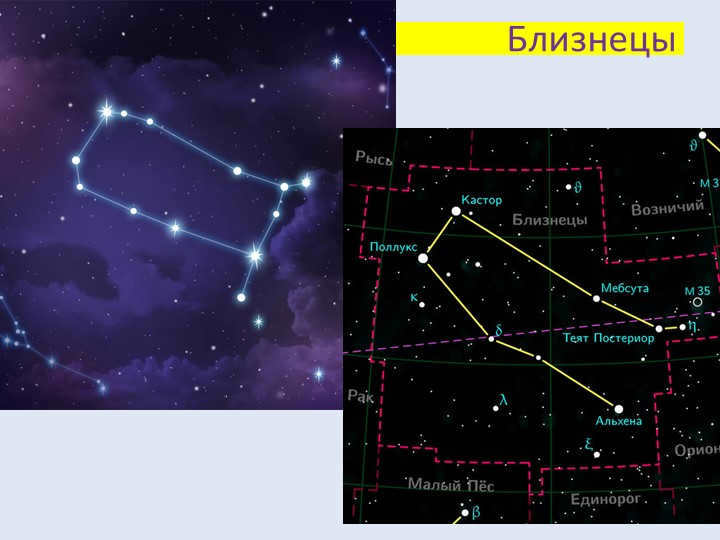

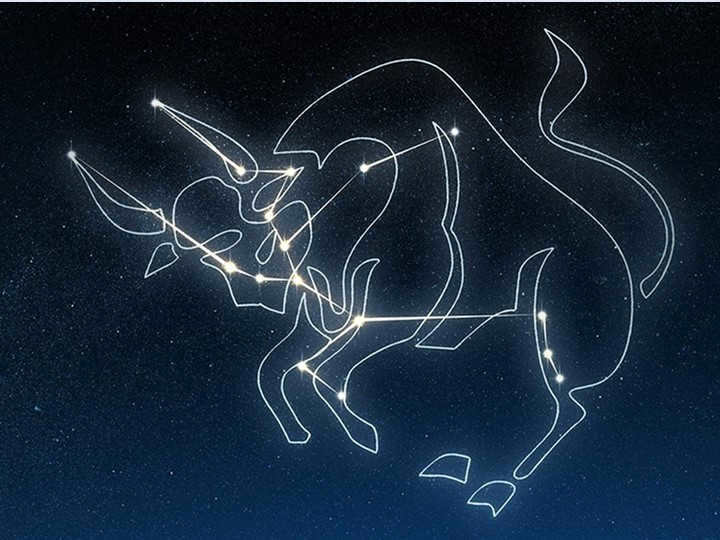
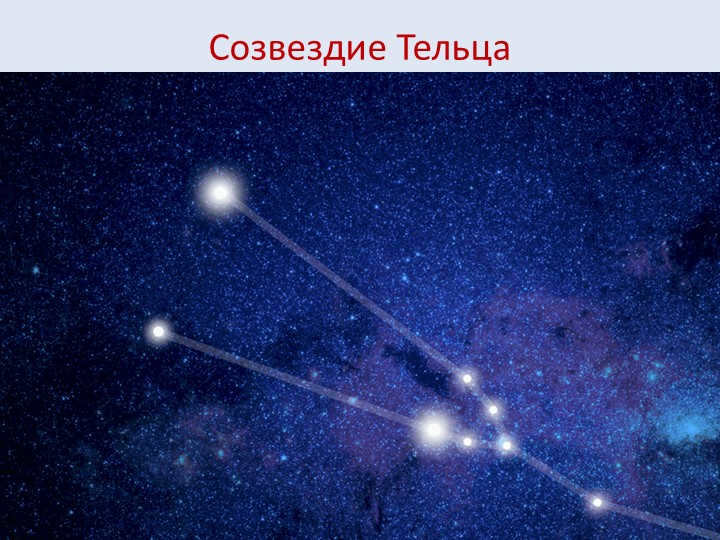
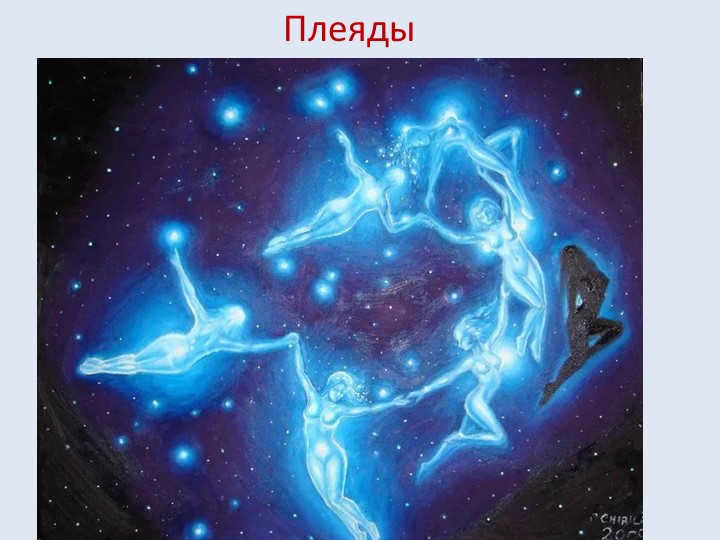
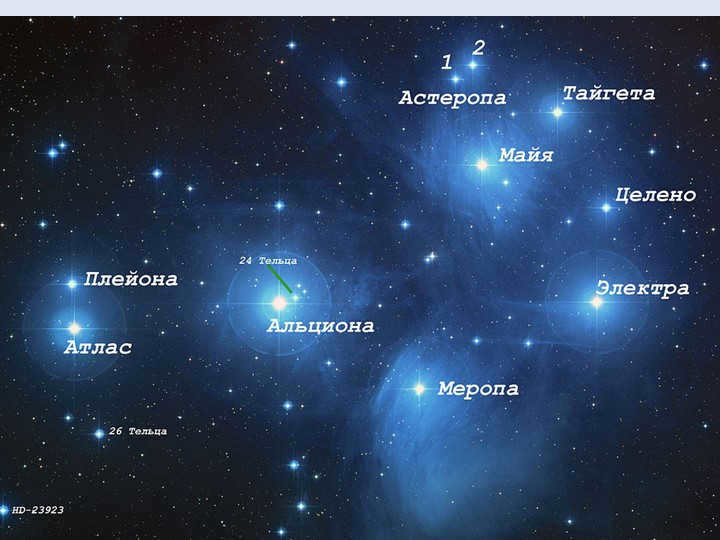
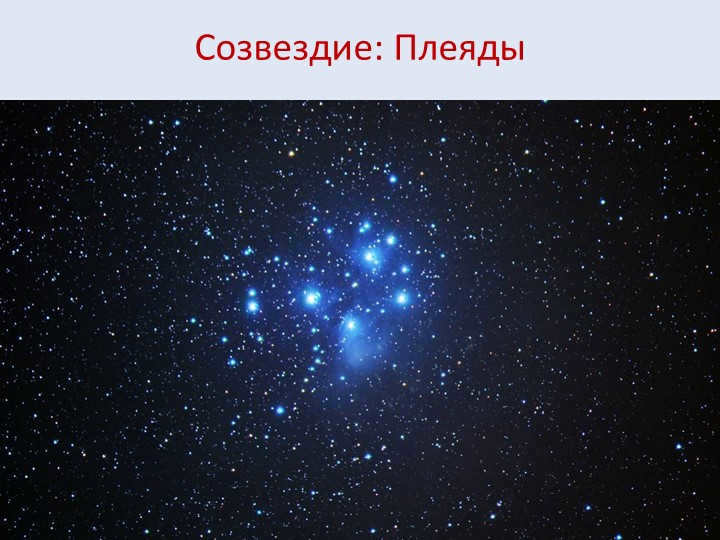
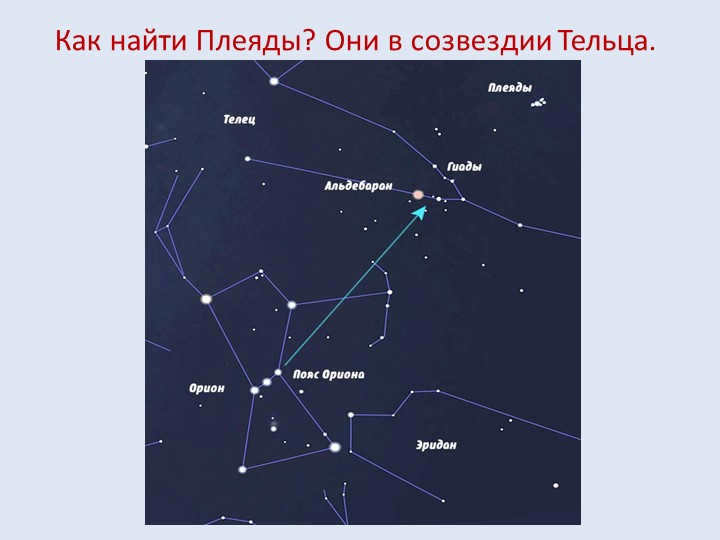
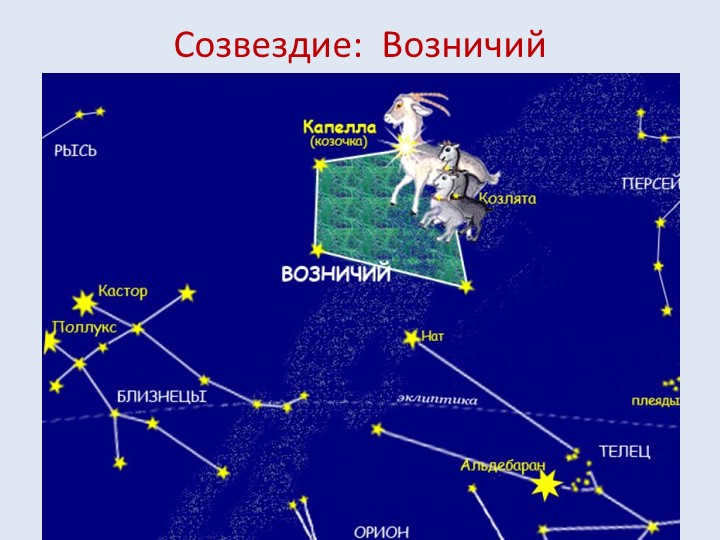
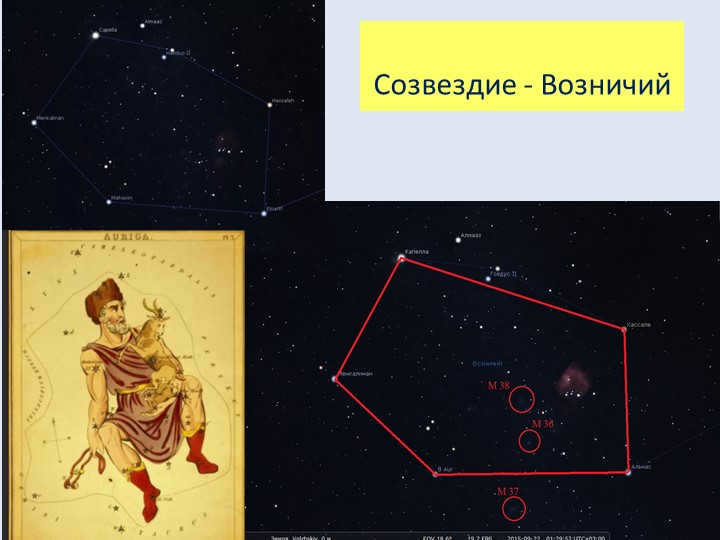
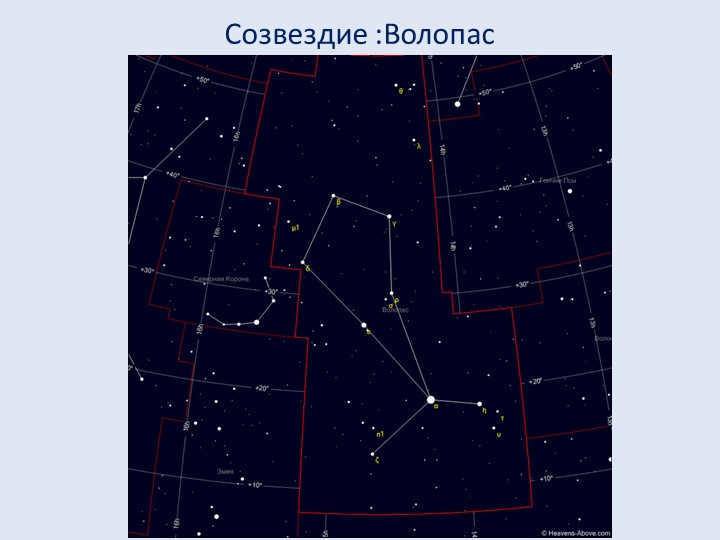
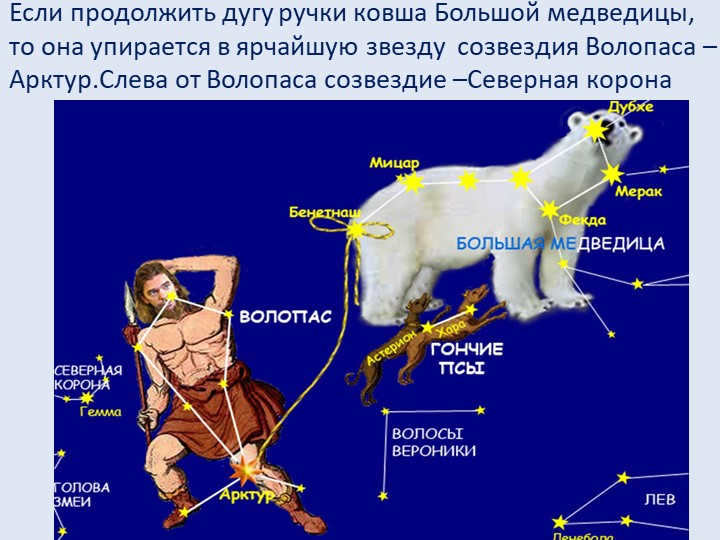
If you extend the handle of the Big Dipper, it will point to the brightest star in the Volopas constellation, Arcturus. To the left of Volopas is the Northern Crown constellation.
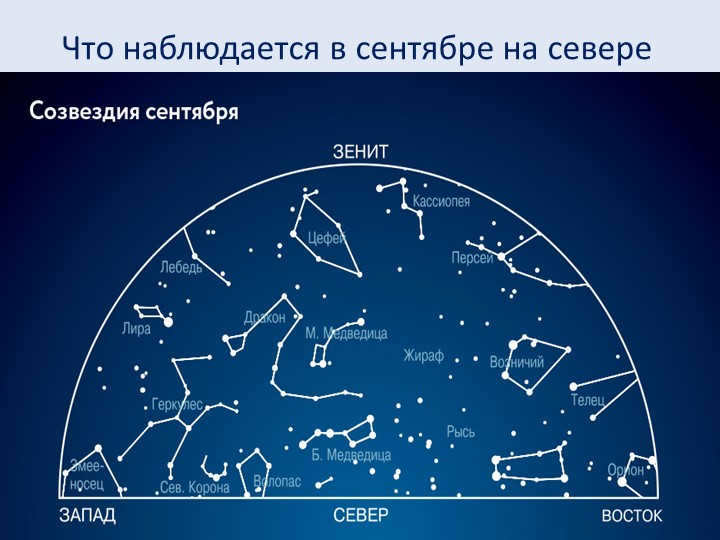
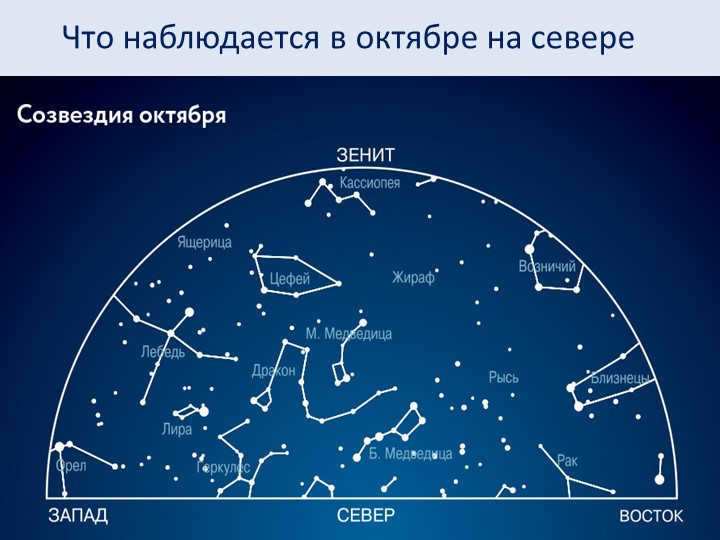
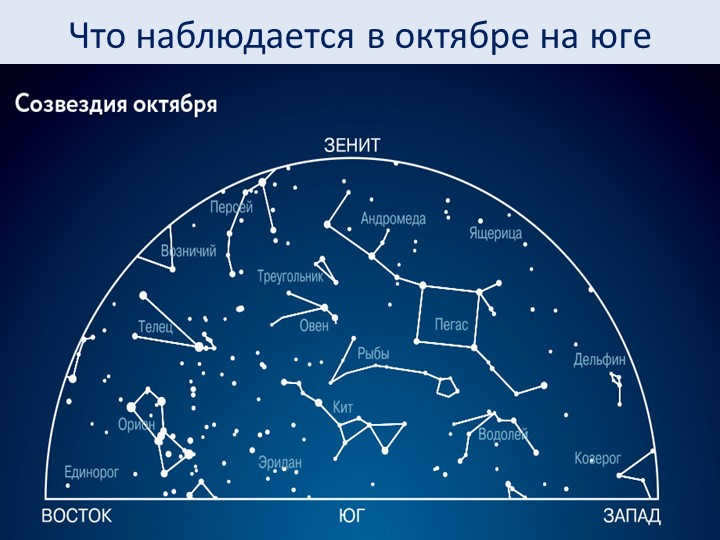
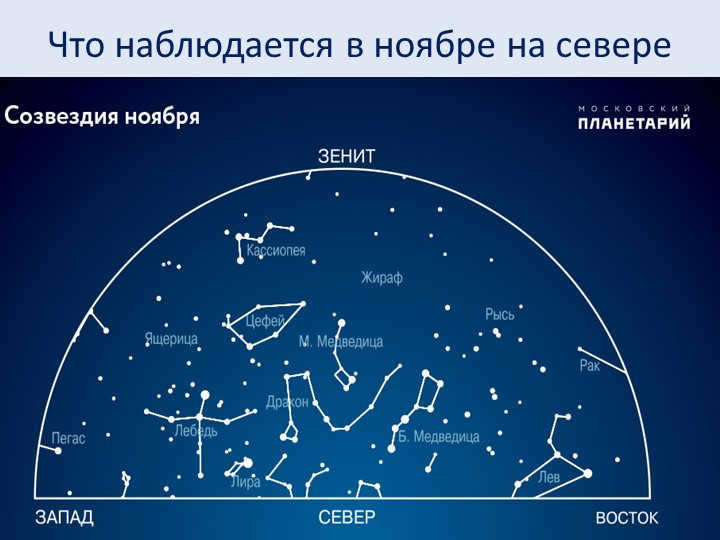
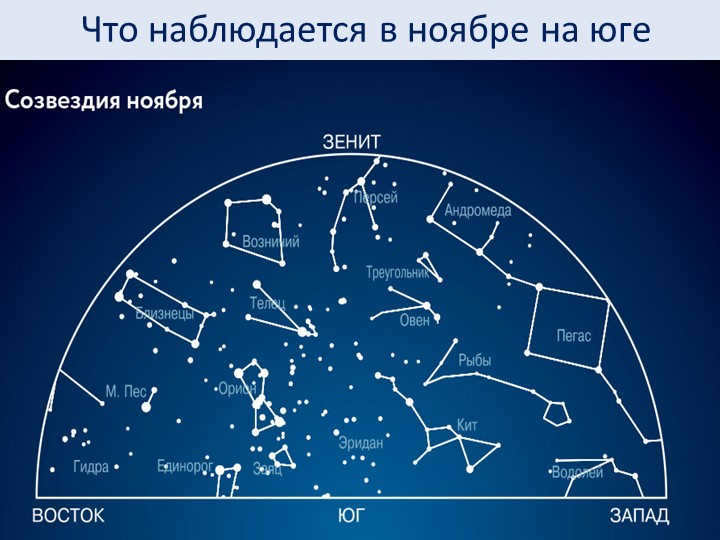
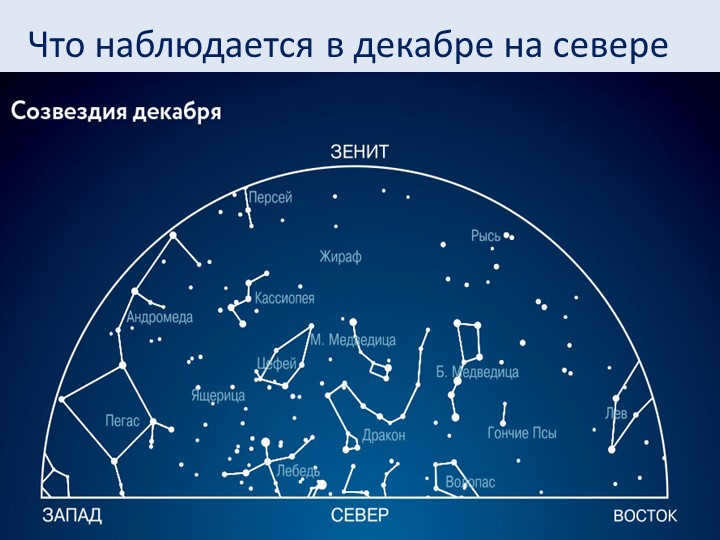
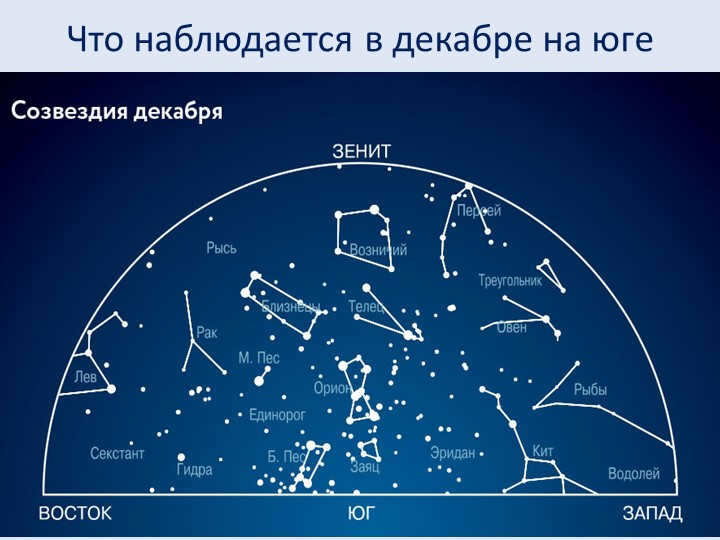
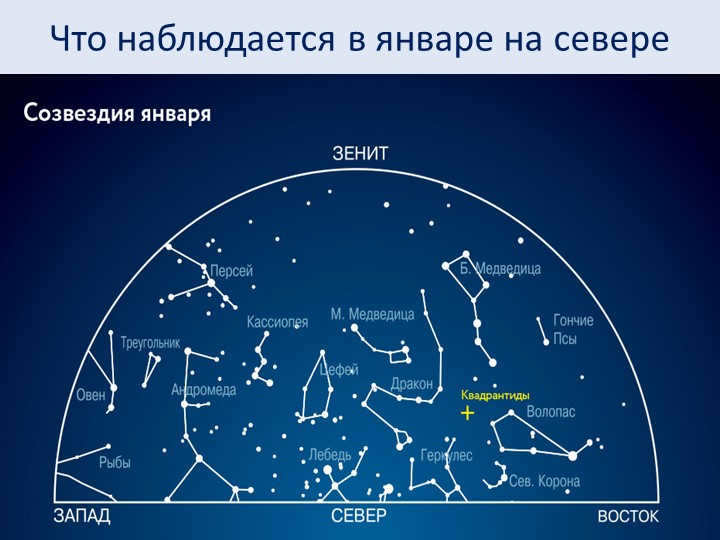
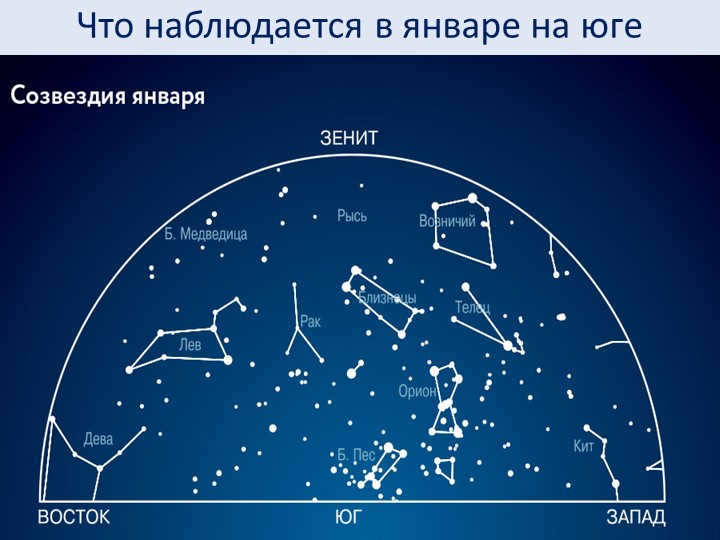
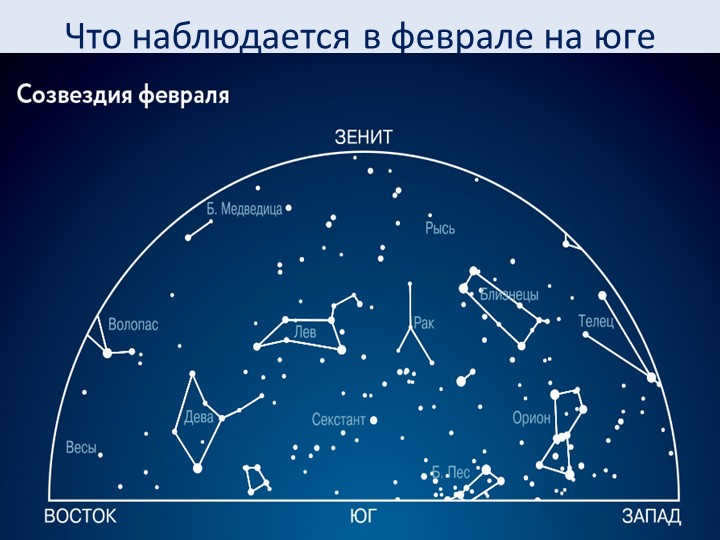
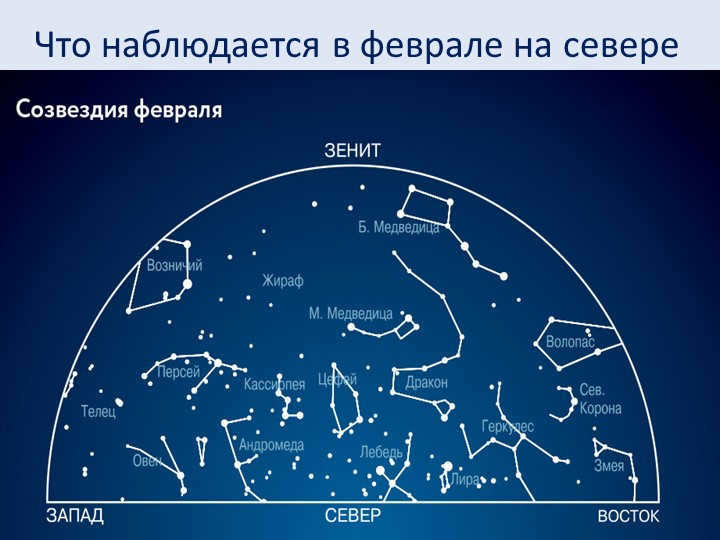
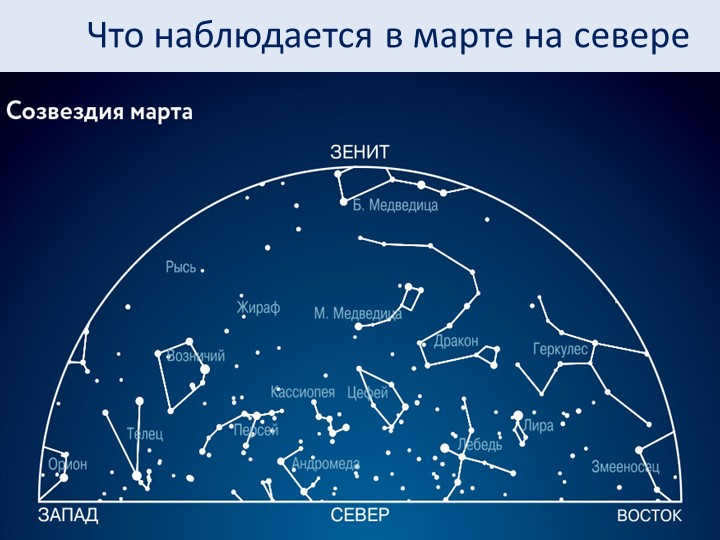
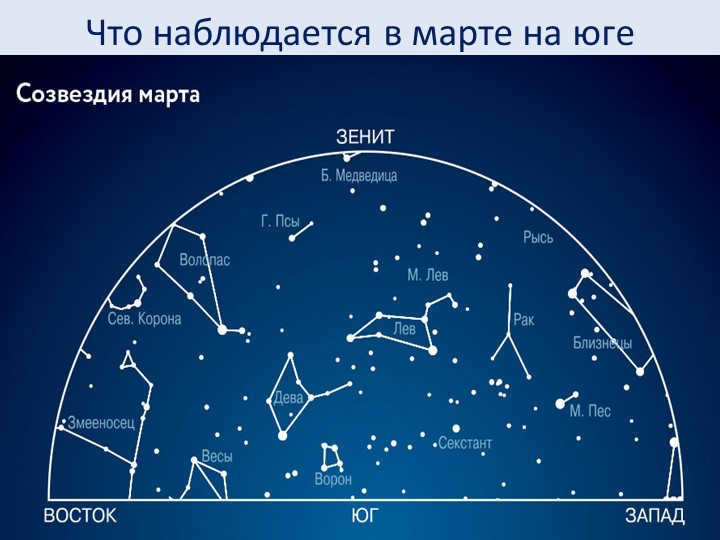
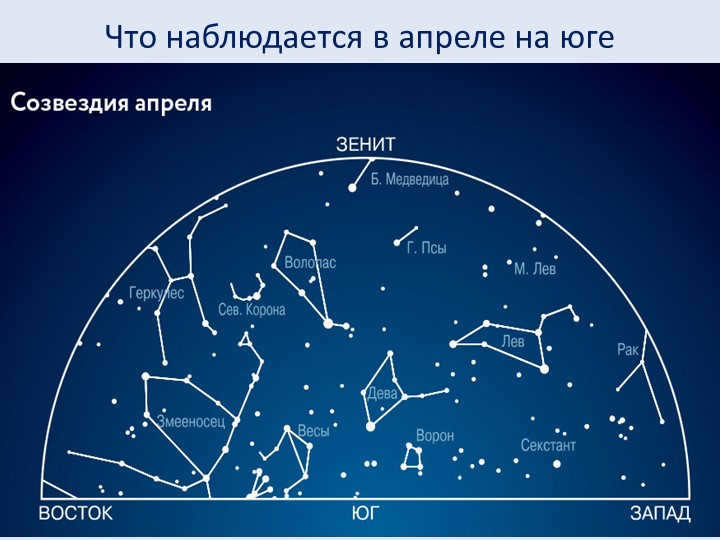
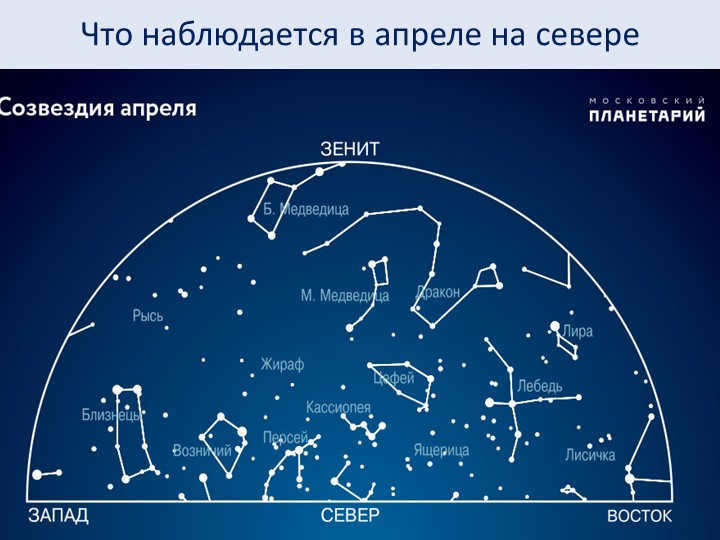
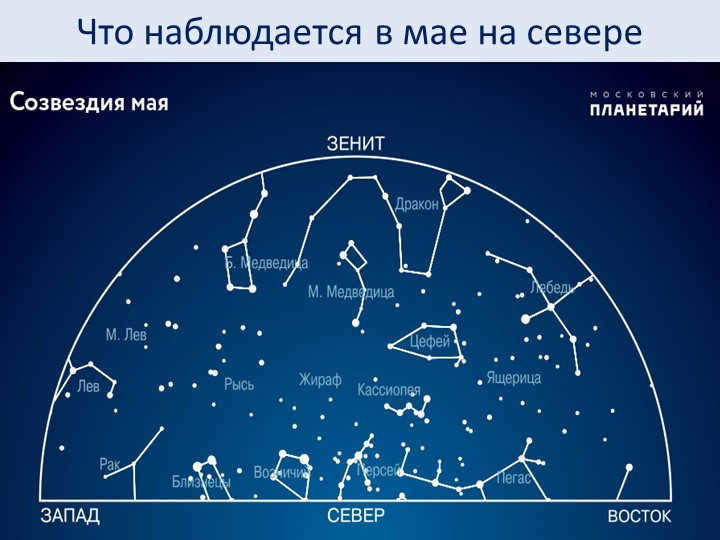
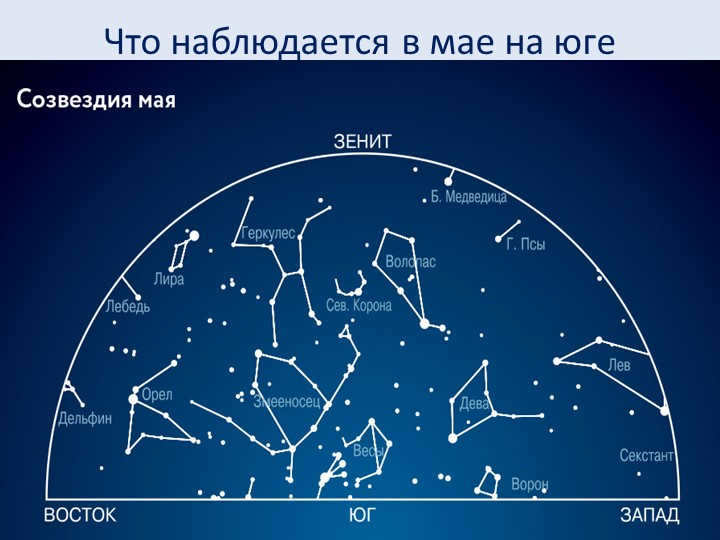
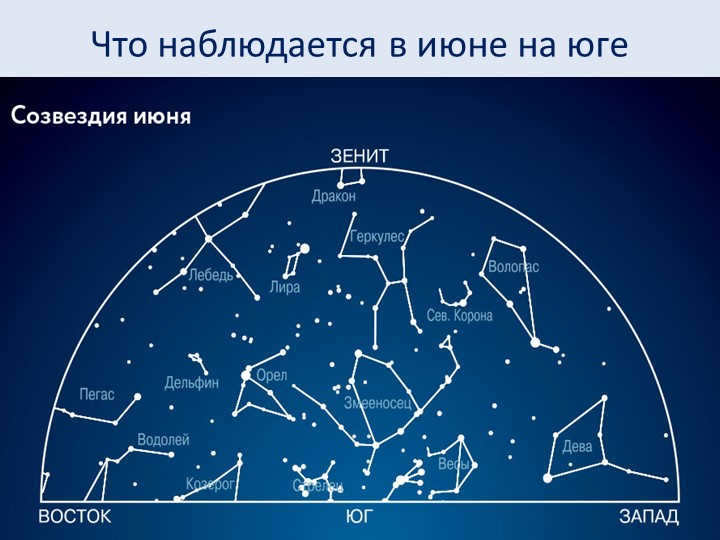
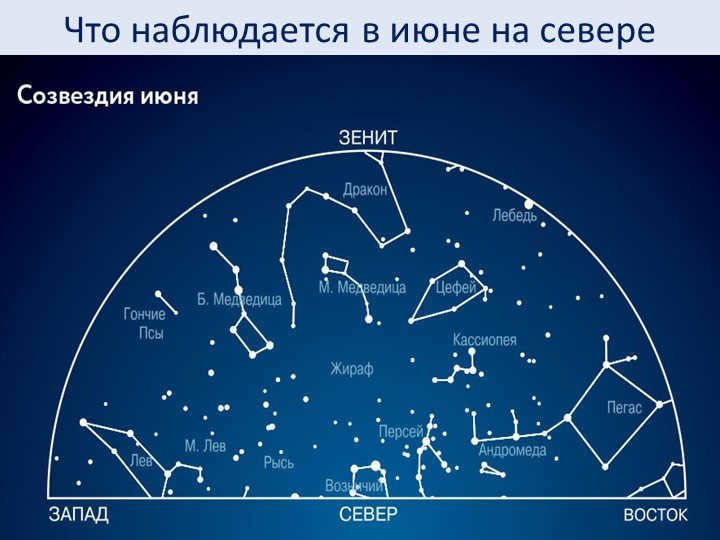
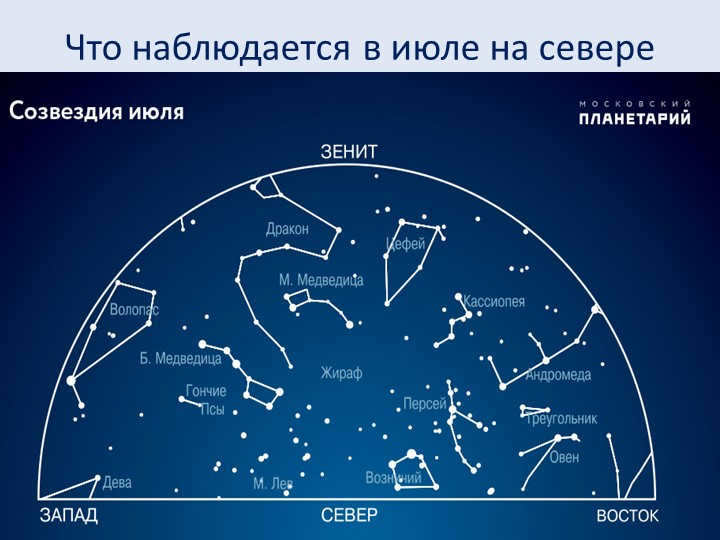
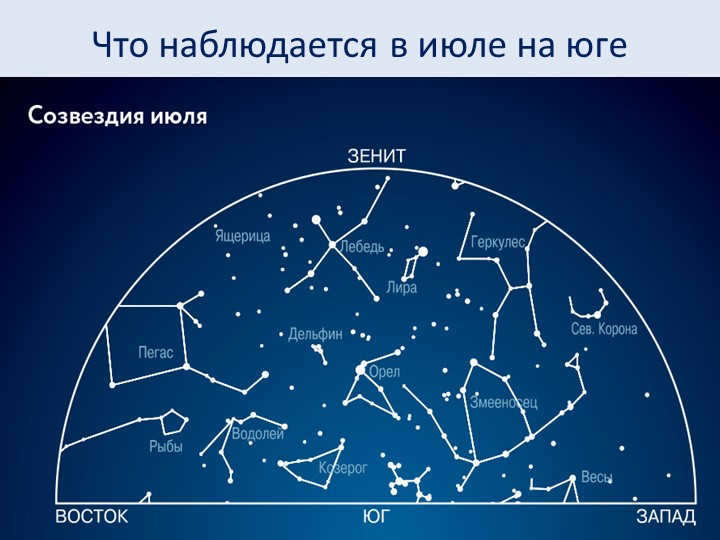
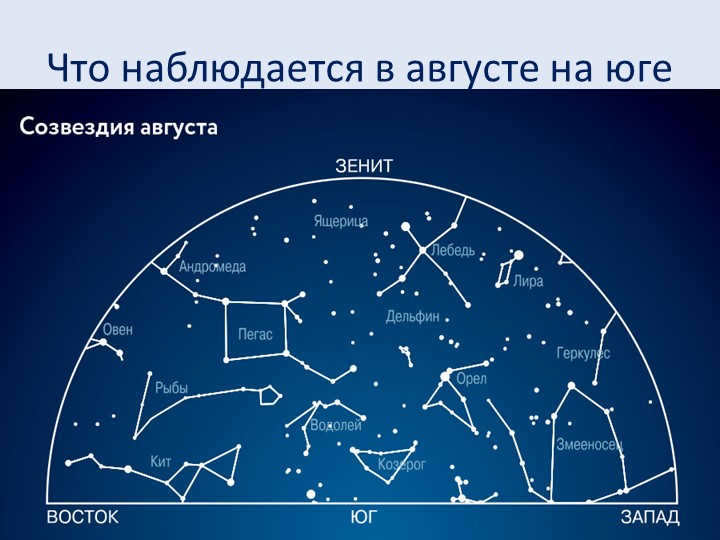
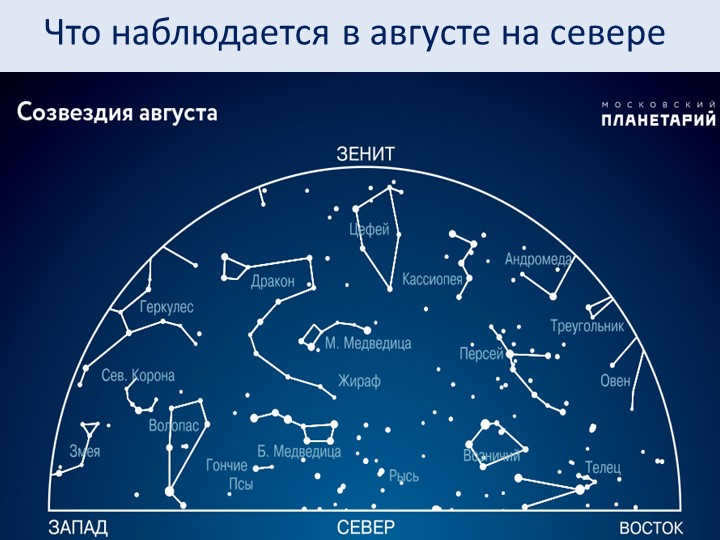
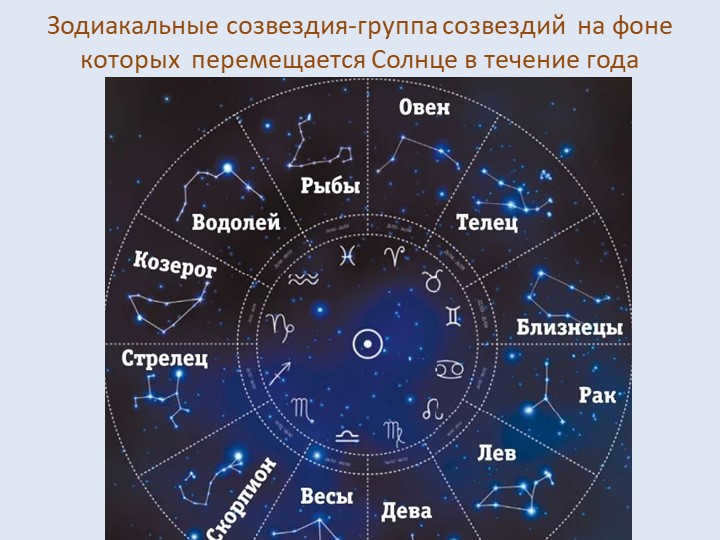
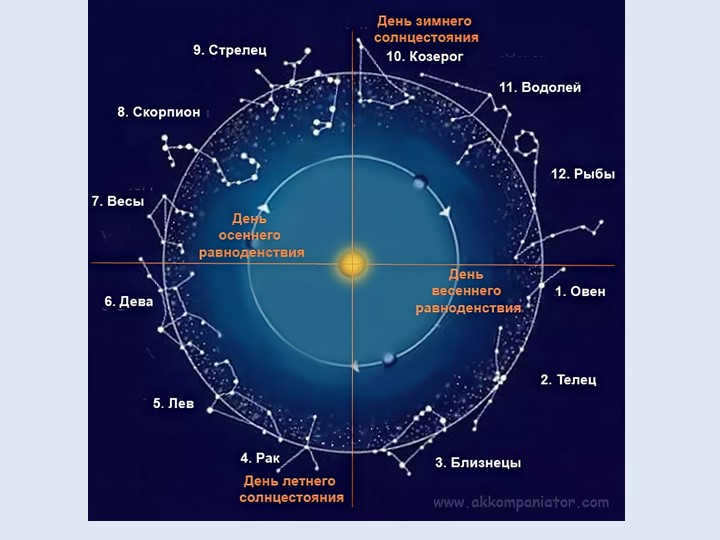
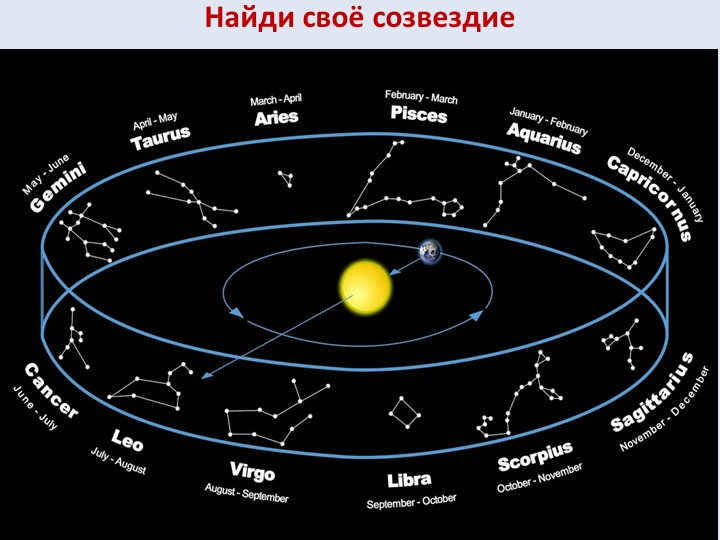
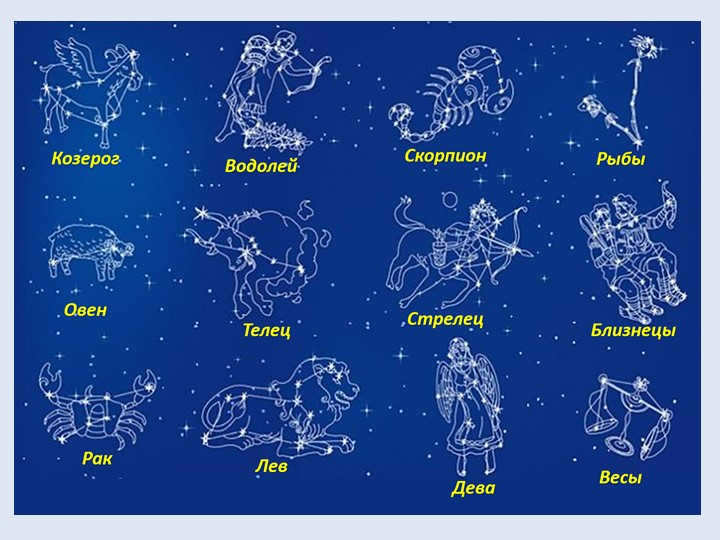

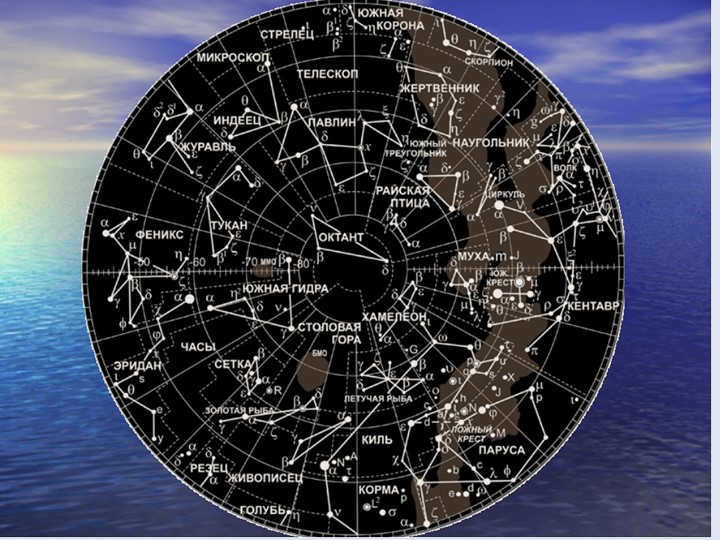
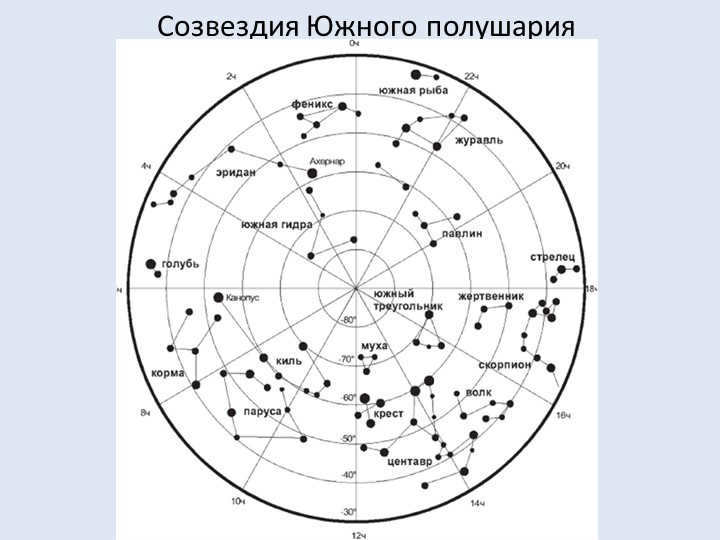
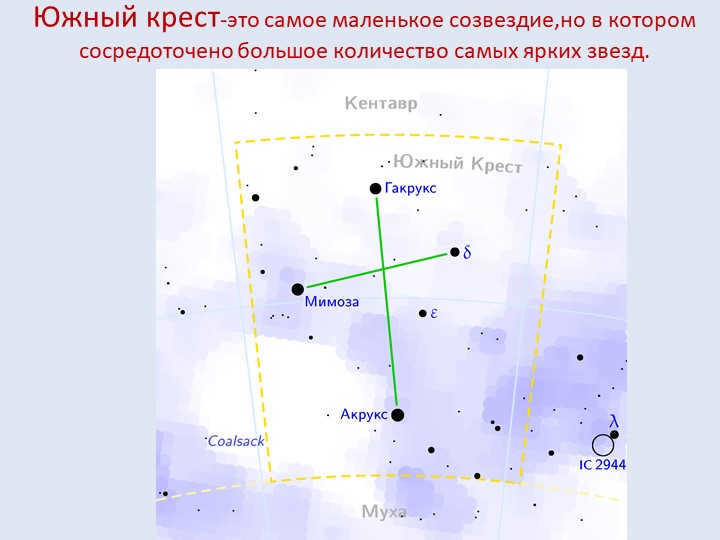
The Southern Cross is known for being the smallest constellation in the night sky, yet it boasts an impressive collection of some of the most brilliant stars.

Summary of the document:
This compilation of information is designed to assist educators and students interested in Astronomy, as well as individuals who enjoy stargazing, specifically those residing in the northern hemisphere of Earth. The content is not affiliated with any specific Astronomy textbook or manual. Interested parties are encouraged to contribute additional astronomical knowledge to enhance the presentation and make it accessible to a wider audience. The presentation aims to provide easy identification of key constellations and aid in navigating the night sky’s star clusters in the northern hemisphere, particularly on cloudless evenings.
Supplementary materials and resources for educators and teachers
Over 10,000 educational resources for both school and home-based learning
Innovations for the upcoming academic year 2023
Interactive seminar for educators and administrators
Discover a wide range of resources for every lesson by selecting your subject (category), grade level, textbook, and topic:
There are 6,330,830 materials available in our database
Additional resources
- Textbook: “Astronomy (basic level)”, authored by Vorontsov-Vel’yaminov B.A. and Straut E.K.
- Topic: Section 14. The movement of celestial bodies influenced by gravitational forces.
These courses will catch your attention:
Feel free to share your thoughts
- Date: 08.01.2022
- File size: PPTX 40.2 MB
- Number of downloads: 47
- Rating: 1 out of 5
- Please rate the material:
If you believe that this material infringes on copyright or should be removed from the site for any other reason, you can leave a complaint about it. Remove material
Material author
- On site: 8 years and 7 months
- Subscribers: 2
- Total views: 160483
- Total materials: 77
Online courses
for educators
117 minutes
28 minutes
112 minutes
Gift Certificates
The users who posted the material on the site are responsible for resolving any disputes regarding the materials and their content. Nevertheless, the site’s administration is prepared to offer assistance in resolving any matters pertaining to the site’s operation and content. If you come across any unlawfully used materials on this site, kindly notify the site’s administration via the feedback form.
All content posted on the website, whether created by the website’s authors or submitted by users, is provided for informational purposes only. The copyrights for these materials belong to their respective authors. Any unauthorized copying or reproduction of the website’s materials is strictly prohibited without written permission from the website’s administration. The views of the administration may not necessarily align with those of the authors.
The distant night sky, adorned with countless shining stars, is particularly captivating during the long winter nights. The crystal-clear nights of frost lend themselves to the perfect visibility of the distinctive constellations of the northern hemisphere. For thousands of years, humanity has been exploring the celestial heavens. The ancient Mayans and Egyptians meticulously crafted astrological calendars long before the advancements of modern science.
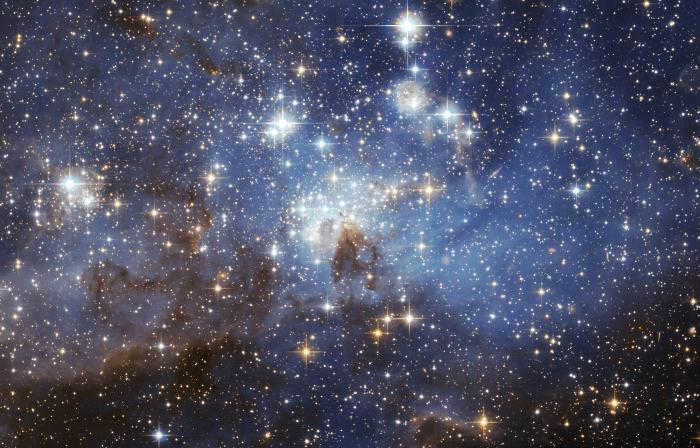
Enchantment of the Stars
In the southern part of the sky, on the evening of February 15, one can marvel at the constellations that belong to the northern hemisphere. Among them is the majestic figure of the mythical Orion, characterized by a belt made up of three brilliant white stars. Adding to the allure, the hunter’s right shoulder is graced by the presence of the vibrant red star called Betelgeuse, which happens to be the brightest star in the entire constellation. It is worth noting that ancient illustrations of Orion always depicted him surrounded by ferocious wild creatures.
Over to the right, just beyond Orion, a furious bull known as Taurus is galloping across the celestial sphere. His eye is gleaming brilliantly – it happens to be the magnificent star Aldebaran (alpha of Taurus). Orion, however, remains undaunted by Taurus’s presence; in fact, he brandishes a club in an attempt to ward off the bull. Accompanying Orion are two loyal hounds, namely the Big Dog and the Little Dog. These constellations are among the most prominent in the northern hemisphere, each boasting stars of the highest luminosity. The Big Dog is home to Sirius, which proudly claims the title of the brightest star in the entire night sky. As for the Little Dog, it is adorned with Procyon, a star that, while perhaps not as dazzling as Sirius, still possesses its own modest charm.
The two prominent constellations in the northern hemisphere are Ascendant and Gemini. Castor and Pollux, the stars α and β in Gemini, are named after the mythical twin children of Zeus.
Capella, a bright yellow star, is located near the zenith and is the primary star of the Ascendant constellation. Capella, which translates to “goat,” is depicted on ancient maps being carried on the mighty shoulders of the giant Ascendant. According to ancient Greek legends, Ascendant was believed to be the dwelling place of Erichthon, the king of Athens, who was also credited with creating chariots. The star on the giant’s shoulder represents the mythical goat Amalthea, who nurtured Zeus himself.
In winter, there are two constellations in the northern hemisphere that are not particularly noticeable due to their lack of bright stars. Adjacent to the constellation Orion on the right is the constellation Eridanus, which is named after the mythical river where Phaethon, the son of the sun god, met his tragic fate by drowning. This celestial “river” extends all the way to the southern hemisphere sky, ending at the prominent star Ahernar. On the opposite side of Orion, we find the constellation Unicorn. This constellation first appeared on maps in 1624, following the invention of the telescope. Its shape resembles a mythical creature that combines the features of a horse and a rhinoceros, a creature that was the subject of many stories during the Middle Ages.
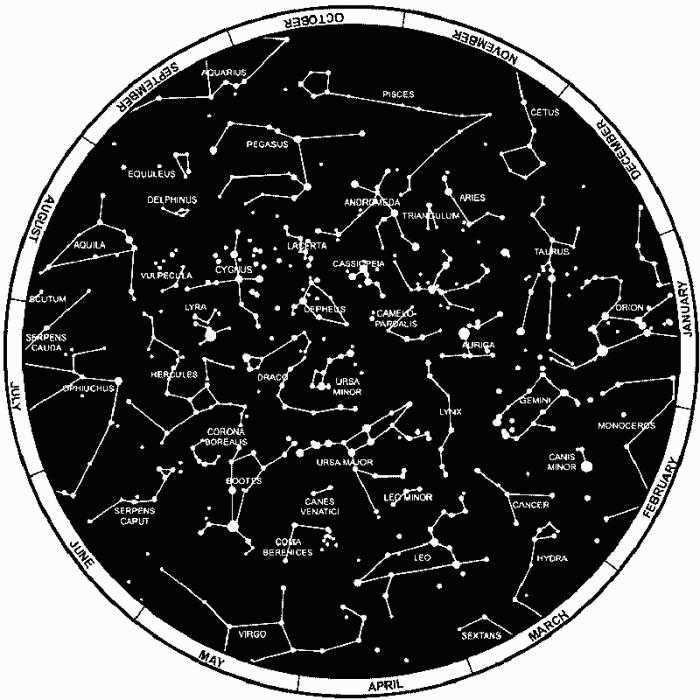
Orion: The Most Brilliant Constellation in the Northern Hemisphere
Among the countless constellations that fill the night sky, none can compare to the magnificence of Orion. This constellation boasts an array of fascinating celestial objects that are easily observable.
Rigel, the brightest star in Orion, shines with a dazzling bluish-white radiance. Its scorching surface temperature reaches nearly 13,000 degrees Fahrenheit. What truly sets Rigel apart, however, is its astonishing luminosity. Emitting light that is 23,000 times brighter than the Sun, Rigel’s brilliance is unmatched. This extraordinary brightness can be attributed not only to its extreme temperature but also to its immense size. Rigel is a supergiant star, a colossal entity that dwarfs the Sun by a factor of 33.
While Rigel is undoubtedly impressive, Betelgeuse takes the prize for being considerably larger. It’s no mere coincidence that Orion is the brightest constellation in the northern hemisphere. Thanks to the use of an interferometer, scientists have been able to measure the cross-section of Betelgeuse multiple times, revealing that it is a whopping 450 times larger in diameter than our Sun! Just to put that into perspective, if we were to replace the Sun with Betelgeuse, this massive star would easily engulf four planets, all the way up to Mars. On the other hand, if we were to swap the Sun with Rigel, the intense heat produced by this bluish-white giant would surely annihilate all life on Earth.
Bellatrix is the third brightest star in the constellation of Orion, after Rigel and Betelgeuse. Despite being less bright than the other two stars, Bellatrix is still a giant star and is actually hotter than Rigel. Its surface temperature exceeds 20,000°. In medieval times, Bellatrix was associated with the mythological figure of a warrior. An astrological book from that era even claimed that women born under this star are generally happier and more talkative.
There is another star in the figure of Orion, designated as χ, which is even hotter than Bellatrix. It has a surface temperature of around 25,000°.
The constellation of Orion also includes two other stars, σ and λ. One of them is the hottest among the brightest and most luminous stars in the constellation, with a temperature close to 30,000°.
The characteristics of the Andromeda and Orion nebulae, which are the most prominent in the night sky, differ greatly. Andromeda is an immense and faraway system that comprises of billions of stars. On the other hand, the Orion Nebula is relatively smaller, with an average diameter of 5 light-years. While the Andromeda Nebula exists as a galaxy in close proximity to our own, the Orion Nebula intersects with our Galaxy approximately 350 light-years away from the Sun.
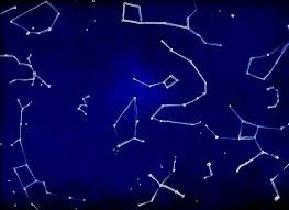
Taurus
It is quite easy to remember the names of the constellations located in the northern hemisphere. When observing Taurus, why not test your visual acuity by counting the number of stars that can be clearly distinguished in the Pleiades? If you are able to count 6 or 7 stars, then your vision is considered normal. However, if you are able to see more than that, then your vision is excellent. Interestingly, Galileo was able to count up to 36 stars using his primitive telescope. The Pleiades star cluster is relatively close to Earth, with the distance between us and them approaching 130 light years. In the sky, the cluster covers an area that is many times larger than the full Moon. The Pleiades stars are spread out in all directions in space for a distance of 22 light years.
The primary star in the Taurus constellation is Aldebaran, which has a yellowish-orange color. Aldebaran is visible from Earth but is not actually part of the constellation itself. Instead, it is located within a cluster of stars known as the Hyades. The Hyades is made up of approximately two hundred stars, each of which has its own unique motion. This motion is quite fast, which is why the cluster appears to be moving rapidly when observed from Earth, leading to its nickname as a “moving cluster.”
All of the stars in the Hyades cluster move in a parallel manner in space, similar to the way railroad tracks are aligned. The Hyades cluster holds the distinction of being the closest cluster of stars to Earth, with a distance of only 40 light-years. Its shape is spherical and it spans an impressive width of approximately 33 light-years. Approximately 80,000 years ago, the Hyades came into close proximity with the Sun, reaching a distance twice as close as their current position. In approximately 6,500,000 years, the Hyades will gradually drift further away from us and occupy a significantly smaller portion of our night sky, comparable in size to the Moon. As a result, the brightest stars within the cluster will only be visible as faint 12th magnitude stars.
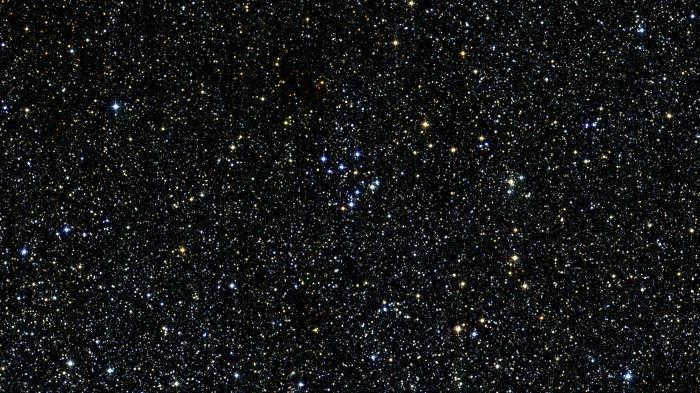
The Crab Nebula
The constellation Taurus, located in the northern hemisphere, is home to a remarkable feature known as the Crab Nebula. Situated near the star ζ, this celestial object is quite challenging to observe from Earth. Only under the cover of a deep, dark night can one catch a glimpse of a small luminous spot, measuring approximately 6’X4′, using a high-quality telescope or exceptionally powerful binoculars. Cataloged as “Taurus A,” the Crab Nebula is renowned for being one of the most potent sources of cosmic radiation. Its structure bears a striking resemblance to that of a crab, with its branches resembling tentacles.
In 1054, there was a remarkable occurrence when a supernova erupted in this location. Presently, there exists a diminutive and peculiar star with an extraordinary spectrum that emits an intense heat, measuring 9 magnitudes. The gas clouds that constitute the Crab Nebula originate from this particular star and disperse in various directions at an astonishing velocity of approximately 1000 km-sec! It is beyond doubt that we are witnessing a former supernova event, whereby the gas clouds were expelled during an immense explosion. This star possesses a temperature exceeding 150000°, a rarity seldom observed in typical stars.
Canine Constellation
“Kanikaly,” a term derived from Latin and adopted into Russian, directly translates to “days of the dog.” This peculiar and seemingly illogical name was given to the summer months due to the prominent star in the Canine Constellation. The Canine Constellation is a group of stars located in the northern hemisphere of the sky.
The star Sirius, derived from Greek, signifies brilliance. In ancient Egypt, Sirius always appeared as the first star in the morning dawn during the summer solstice. Priests would closely observe the constellations in the northern hemisphere during winter, and upon recognizing this significant event, they would anticipate the flooding of the Nile and the onset of scorching summer days.
The primary celestial body in the constellation is Sirius, which was known as the Dog Star in ancient times. This name was derived from the Latin word “canis”, meaning dog. As a result, the scorching summer days of leisure were referred to as “vacations” or “dog days” by the ancient Romans. During this distant period, vacations were a source of concern for people, as it was believed that the Dog Star was responsible for causing rabies and fever.
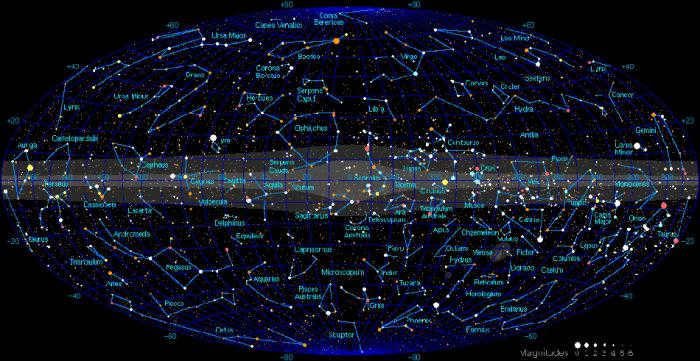
Sirius is known as the most luminous star in the sky. It emits a beautiful blue light with an intensity level reaching l m , 4. Apart from Sirius, there is only one other star (Capopus) that shines with negative stellar magnitudes. Sirius is located relatively close to our planet and ranks as the seventh closest star to the Sun. If you were to embark on a spaceship and travel to Sirius at a speed of 10 kilometers per second, it would take an astonishing 300 thousand years to reach your destination. The light emitted by Sirius reaches us after a journey of 9 years. In terms of size, Sirius is twice as large as the Sun. It also possesses twice the mass and is hotter than our very own star. In fact, the light emitted by Sirius is 24 times more intense than that of the Sun.
Sirius has a white companion star known as the Puppy, which has a magnitude of 8 m,6. This star is actually the first white dwarf ever discovered by humans. The Puppy has the same mass as the Sun but is only three times bigger than Earth. To put things into perspective, if you were to condense all of its matter into a matchbox, it would weigh nearly a ton.
Underneath Sirius, you can witness a unique star of the Wolf-Rayet type, known as o 2. Positioned between Sirius and o 2 is the dazzling star cluster M41. Notably, the UW stars, classified as supergiants belonging to spectral class O 8, are exceptional. These stars are the most massive ones that have been investigated. Each of them boasts a weight approximately 30 times that of the Sun, and a mass that exceeds Earth’s by a factor of ten million!
Puppy
The constellations that dominate the winter sky in the northern hemisphere would not be complete without the Little Dog. The main star in the constellation of the Lesser Dog is Procyon, which has a yellowish tint. While not as prominent as Sirius, Procyon also has a white dwarf as a companion. Procyon is more luminous than the Sun, and it is slightly larger and hotter. Its temperature can reach up to 7000°. Procyon is located relatively close to Earth, at a distance of 3.5 light years.
Procyon’s companion is a small star with an 11th magnitude. Only professional astronomers are able to observe it. This dwarf star emits radiation that is ten times fainter than that of its companion Sirius. Interestingly, this dwarf star is even denser than Puppy. Thus, Sirius and Procyon, two different star systems, share the common characteristic of having dwarf companions.
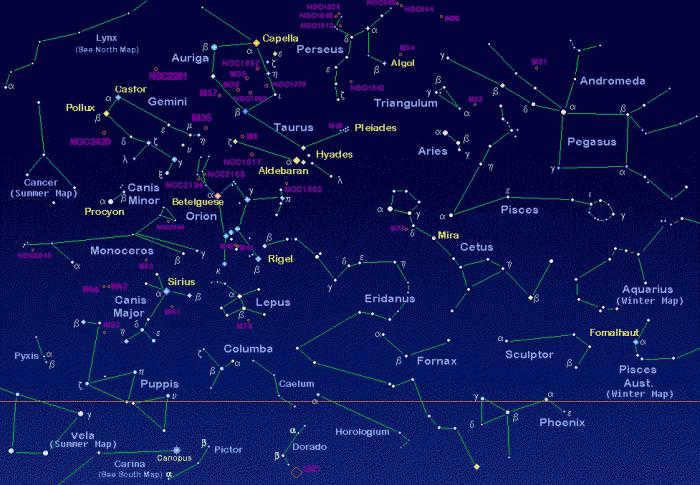
The Twins
Castor and Pollux are the standout stars in the Gemini constellation, each with their own unique characteristics. Without them, the constellations of the northern hemisphere night sky would lose their brilliance.
Castor consists of two blue hot stars. Pollux, on the other hand, is a single cool orange star. Pollux is the closest to us, at a distance of 10 light years, while Castor is 14 light years away. While Pollux is not particularly noteworthy, Castor is a rare and unique star. It is composed of two luminaries, 2 m,0 and 2 m,9, with a separation of 4″,1 between them. These two components are known as Castor A and Castor B. They are twin stars in terms of their spectral characteristics and are separated by only 10 million kilometers. To put this in perspective, the distance from the Sun to Mercury is six times greater. Located 73″ away from Castor A and B is Castor C, which is a small reddish dwarf. Just like Castor A and B, Castor C is made up of twin dwarfs that are nearly 3 million kilometers apart, resembling two miniature Suns.
As a result, Castor can be considered a “six-pointed” star. If there are any planets orbiting around it, they would be able to witness the presence of six suns in their sky simultaneously!
Ascendant
Ascendant is a star grouping located in the sky of the northern hemisphere. Capella, a dazzling yellow star with a magnitude of 0m,09, serves as the main star of this constellation. It is comprised of two giant stars that emit a yellow hue. Interestingly, the distance between these two stars is equivalent to the radius of Earth’s orbit. Despite their close proximity, their duality cannot be observed through a telescope due to their small angular separation. However, through spectral analysis, scientists have been able to confirm the existence of these two stars. Furthermore, it has been determined that these stars orbit each other, completing one revolution every 104 days, which is equivalent to the duration of an Earth year.
The second brightest star after Capella is the p of Ascendant, which undergoes periodic changes in its brightness. Of particular interest is the ζ system of Ascendant, which is comprised of two stars that differ in every aspect. The first star is a hot bluish-white star with a gravity 13 times that of the Sun. The second star is a reddish-orange supergiant with a gravity 30 times that of the Sun and a size 300 times larger. Such an enormous star would be able to contain the orbits of all the planets up to Mars if it were located at the position of the Sun.
Epsilon Ascendant is a variable star with an extraordinary period of change in brightness, lasting 27 years. This stellar system is composed of two stars, one of which is bright and the other is dim. The star we observe appears yellowish and is a supergiant with a temperature of 6300°. It possesses a gravity 36 times stronger than that of the Sun and is 190 times larger in size. The second star, although invisible to us, is even more massive. In fact, it is the largest star known to humankind, with a diameter 2,700 times greater than that of the Sun, which is big enough to encompass the entire solar system. However, its luminosity is relatively faint, almost equivalent to that of the Sun, due to Epsilon A’s cold temperature and low density.
Observing the constellations in the northern hemisphere can be a fascinating experience. The Ascendant constellation, in particular, offers a unique opportunity to witness extraordinary eclipsing variable stars, as well as scattered clusters of stars like M 36, 37, and 38. These clusters consist mainly of hot white B-class stars and cool Sun-like stars, creating a diverse and captivating celestial spectacle. With approximately 350 stars spread across the three clusters, there is no shortage of celestial wonders to explore.

Unicorn
Although not a small constellation, Unicorn does not have a large number of bright stars. Its most fascinating feature is the Rosette Nebula, which is in the shape of a diffuse disk and is located at a distance of 1100 light years. This nebula is illuminated by hot O-class stars from within and has a diameter twice that of the Moon.
Eridanus
Eridanus is a constellation in the northern hemisphere that is home to the triple star system ο 2 Eridanus. This system consists of a primary star with a magnitude of 4 and two companion stars with magnitudes of 6 and 9. The primary star is similar to our Sun, but smaller and cooler. The first companion star is a cold red dwarf, much smaller than the Sun. The second companion star is a white dwarf, significantly smaller but much denser than the Sun. The two companion stars orbit around each other every 250 years. This triple star system is located relatively close to us, only 5 light-years away.








